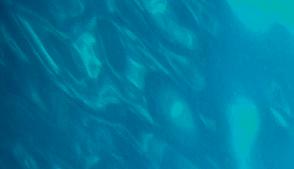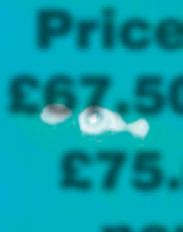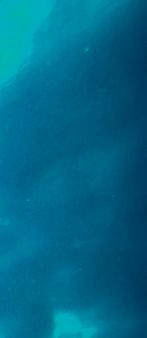











































































































SmartFlow connects all Vaki Smart Pumps, Graders and Counters for full overview and control of the fish handling system.
To find out how SmartFlow can revolutionise your business, contact your MSD Animal Health account manager.












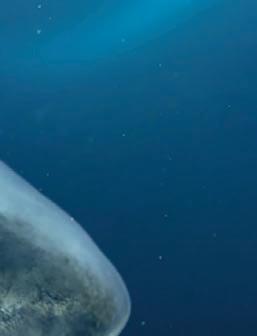









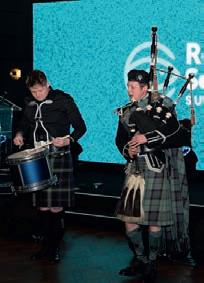

























































































































SmartFlow connects all Vaki Smart Pumps, Graders and Counters for full overview and control of the fish handling system.
To find out how SmartFlow can revolutionise your business, contact your MSD Animal Health account manager.



































THE town of St Andrews is used to welcoming visitors from all over the world, and last month it hosted another big event.
This time, though, it was not a golf tournament that drew an international crowd to Scotland but the Responsible Seafood Summit, co-hosted by the Global Seafood Alliance and Seafood Scotland.
The summit covered a host of topics on the theme of sustainable seafood, covering catch fishing and aquaculture, and provided a unique forum for the exchange of ideas, experiences and insights. Fish Farmer’s report on the summit appears in this issue.
Oban, on Scotland’s west coast, was the venue for the Association of Scottish Shellfish Growers’ annual conference and this too was an opportunity to talk about the challenges and opportunities for the shellfish farming sector, and you can also read about that in the November magazine.
Also in this issue, we look at a report that outlines how an initiative to kick-start sea farming in Wales could potentially prove to be a huge boost to the “blue economy”.
Sandy Neil reviews the arguments presented to the ongoing follow-up inquiry into the salmon industry by the Scottish Parliament’s Rural Affairs and Islands Committee.
Vince McDonagh reports on the troubling levels of sea lice now being encountered in Norway’s northern waters; and on concerns over the lack of growth for the aquaculture sector in the European Union.
Dr Martin Jaffa reacts sceptically to a poll that suggests consumers are ready to pay more for fish produced to higher welfare standards; and Nick Joy reflects on a UK Budget that included some bad news for small businesses.
We also have a report from the latest Aqua Agenda webinar hosted by Fish Farmer, on Land Based Strategy. Our expert panel comprised Thue Holm of Aquafounders Capital, Trond Schaug-Pettersen of Salmon Evolution and Paul Howes, Manager at the Centre for Sustainable Aquatic Research, University of Swansea. Don’t forget to sign up for our next webinar, on Technology, Remote Monitoring and Artificial Intelligence, which takes place on 19 February – see the UK News section for details.
Best wishes Robert Outram
Meet the team
Editorial advisory board: Steve Bracken, Hervé Migaud, Jim Treasurer, Chris Mitchell and Jason Cleaversmith
Editor: Robert Outram
Designer: Andrew Balahura
Commercial Manager: Janice Johnston
o nston s armerma a ine om
O ce Administrator: Fiona Robertson
ro ertson s armerma a ine om
Publisher: lister Benne
@fishfarmermagazine
@fishfarmermag
www.fishfarmermagazine.com
Fish Farmer Volume 47, number 11
Contact us
Tel: +44(0)131 551 1000
Fax: +44(0)131 551 7901
Email: editor s armerma a ine om
Head o ce: e ial li a ons, e es ar , 496 Ferry Road, Edinburgh EH5 2DL
Subscrip�ons address: Fish Farmer ma a ine s s ri ons, arners ro li a ons l , e Mal n s, est treet, Bo rne, Lincolnshire PE10 9PH
Tel: +44(0)177 839 2014
K subscrip�ons: £75 a year
RO subscrip�ons: £95 a year including postage all air mail
Tavish



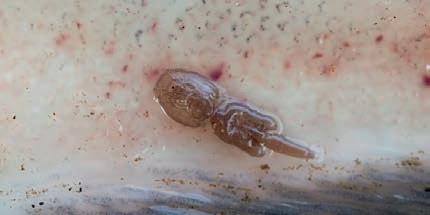






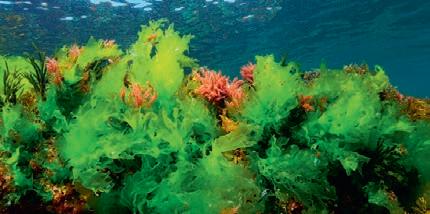























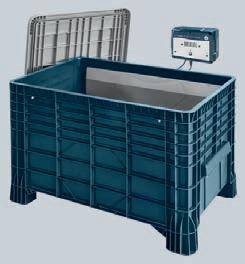


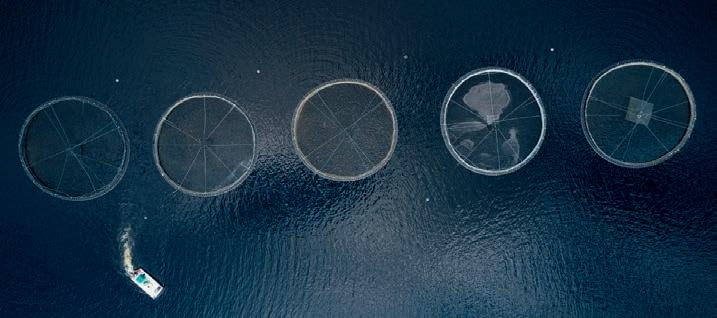
THE Scottish salmon industry’s woes last year have been highlighted in official statistics that show farmed Atlantic salmon production fell by more than 18,000 tonnes in 2023 to 150,949, a year on year decline of 11%.
The Scottish Government’s Scottish Fish Farm Production Survey 2023 also shows that the total number of smolts produced in 2023 decreased by 3.6 million (7%) to 51.5 million.
The publication details statistics on the employment and production from cottish fish farms. t is structured to follow industry trends within the farmed Atlantic salmon, rainbow trout and other species sectors.
n 2023, the total number of staff directly employed in salmon production was 1,480 staff, a decrease of 28 staff compared with 2022. The staffing figures refer to production of Atlantic salmon in seawater and do not include staff involved with processing or marketing activities.
The picture was more positive for rainbow trout. Production in this sector increased by 6% in 2023 to 9,258 tonnes.
This is the highest level of rainbow trout production recorded in Scotland.
Brown and sea trout production decreased to 16 tonnes in 2023.
Meanwhile, Scotland’s salmon industry has reported the best September survival rate for Scottish salmon since 2020. ew figures published in October revealed a 98.18% survival rate on farms in September, which is historically the most challenging month for salmon in the sea.

which has created better conditions for salmon, but industry body Salmon Scotland has also stressed the importance of the resources invested in fish health over the past few years, including £975m spent since 2018 in freshwater treatment vessels, investment in research, a reduction in the time that farm-raised salmon spend at sea, as well as staff training and improved monitoring systems to help farmers respond to natural challenges such as ellyfish blooms and warming seawater. Salmon Scotland says the situation has transformed significantly since then, with production up 15 in the first half of 2024 (to 86,600 tonnes from around 75,000 tonnes) compared to the same period last year.


Tavish Scott, chief executive of Salmon Scotland, said: “Scottish salmon farmers provide the highest standards anywhere in the world for the animals in their care, and have invested £1bn in fish health and welfare since 2018.
The percentage of mortalities was around half the rate recorded in September last year, when warm sea temperatures in the autumn led to micro ellyfish blooms which can harm fish. fter two very challenging years, survival rates in 2024 have been consistently high, reaching 99.03% in June.
2024 saw a cooler, wetter summer
“And while no farmer wants to lose any animal, the care our farmers provide means that survival rates for farm-raised salmon – which spend up to 18 months in the sea – are dramatically higher than their wild cousins.
t is testament to the dedication of farmers that survival rates on Scottish salmon farms are now at the highest level since 2020.”
Look out for more details from the Fish Farm Production Survey in the Fish Farmer Yearbook, published next month.
THE Scottish Seaweed Company was a winner in two categories in the Scotland Food & Drink Excellence Awards, which were held on 9 October.
Two products in the company’s Shore range of snacks were declared best in class: its Peking Duck Seaweed Chips were named Healthier Choice Product of the Year, while Shore Sweet Sriracha Seaweed Chips won in the Snacks and Accompaniments category.
The overall winner on the night as Scottish Product of the Year was another seafood offering, the Fishwife Pie from Carnoustie-based restaurant and piemaker WeeCOOK, known for its unique blend of traditional and modern Scottish cuisine. Judges praised the brand’s award-winning pies and dedication to utilising
seafood sourced from local waters, such as Arbroath smokies, Shetland mussels, and North Sea haddock.
Hosted by TV personality Simon Rimmer, host of Channel 4’s Sunday Brunch, the awards ceremony in Glasgow was attended by 500 people from across the food and drink industry.

Ashley Connolly, Local Buying Manager for Scotland at headline sponsor Asda, headed up the judging panel for the tasted product categories. She said: "This year’s judging was one of the toughest yet, with so many exceptional products on offer – a true reflection of the outstanding quality across the industry. Congratulations once more to all the winners, who really stood out in an incredibly competitive field."
A STEEL signing event on 7 November has marked the e innin o t e final p ase o construction or a ne sustaina le a uaculture researc acilit at t e niversit o Stirlin
e ational uaculture ec nolo an nnovation u is inten e to rive t e s a ition to e a orl lea er in o ern a uaculture practice
isitin politicians an senior universit lea ers si ne t e steel structure an a pla ue ic ill e un in a ter it opens ne t sprin
e state-o -t e-art acilit is un e a invest ent t e overn ent t rou t e Stirlin an Clack annans ire Cit e ion eal as ell as a ol son oun ation rant ill e ull inte rate into t e universit s orlreno ne nstitute o uaculture o ic inclu es a lar escale arine acilit at ac ri anis in int re an a res ater acilit at uckie urn near enn
Pro essor Sir err cCor ac Principal an ice-C ancellor o t e niversit o Stirlin sai e ne ational uaculture ec nolo an nnovation u ill create t e s lea in innovation co unit or sustaina le a uatic oo pro uction an position innovation an pro uctivit at t e ore ront o one o t e orl s astest ro in sectors
e acilit is also t e catal st or t e creation o a ran e o i value skille o s an trainin opportunities in t e lue econo space
Secretar o State or Scotlan an urra P sai elco e t e pro ress ein a e to eliver t is pioneerin a uaculture pro ect acke overn ent un in - part o our co it ent to t e Stirlin an Clack annans ire Cit e ion eal - it is a reat e a ple o colla oration to fin innovative solutions or oostin pro uctivit creatin o s an i provin sustaina ilit in t e sector in Scotlan an e on
Pro essor Si on ac en ie ea o t e nstitute o uaculture sai ur vision is to tackle lo al pro le s o oo

Above: Steel signing at NATIH: (L-R) Councillor Gerry McGarvey, Depute Leader of Stirling Council; Professor Simon MacKenzie, Head of the Institute of Aquaculture, University of Stirling; Professor Sir Gerry McCormac, Principal and Vice-Chancellor, University of Stirling; Eileen chofield, hief Operating Officer and niversity ecretary avid airns, Regional Managing Director, Robertson Construction Central East
securit un er an sustaina ilit t rou a uaculture e ne ational uaculture ec nolo an nnovation u ill elp us uil on our international reputation or orl -class researc teac in tec nolo ical innovation an consultanc in a uaculture supportin ro t in t e pro uction o a uatic oo or u an consu ption contri utin to lo al oo securit ile re ucin t e i pact on natural resources ill inclu e ei t separate te perature-controlle res ater S recirculatin a uaculture s ste s units capa le o operatin in a ran e ro C to C s ell as acilitatin researc it ill ean ore opportunities or un er ra uates an post- ra uate stu ents to et an s-on e perience an or colla oration it lar e an s all partners in t e private sector

THE next edition of leading trade show Aquaculture UK is moving to Glasgow, it has been announced.
The organisers, Diversified Communications, said the show, which has been held in the Highland resort of Aviemore for many years, will take place at the SEC, Glasgow, (pictured) on June 16 and 17, 2026. The 2026 Aquaculture Awards are scheduled for the night of June 16, 2026.
Diversified said: “For many years, Aviemore and, in particular, the Macdonald Resort, has been a wonderful host, providing a unique and memorable experience for everyone who has attended the show.”
However, with planned building development taking place on the land Aquaculture UK occupies, an alternative long-term base had to be found for the biennial exhibition and conference.
The company said the overriding feedback received from both exhibitors and visitors in post-event surveys was that Glasgow offers the best location.
The case for Glasgow, Scotland’s biggest city, is that it boasts a wider range of accommodation and improved transport links, making it more accessible for national and international attendees and providing scope for the event to scale up further in future.
The past two editions in the Scottish Highlands have been stretched to capacity due to the increasing demand for exhibition space and attendance at the popular Awards Dinner. As a result, relocating to a bigger venue has become inevitable for the events continued success and future growth.
Aquaculture UK Director, Cheri Arvonio, said: “This decision hasn’t been made lightly.We deeply value our time in Aviemore and are hugely grateful for the warm hospitality and beautiful surroundings that have helped make Aquaculture UK what it is today.
“However, with no guarantee of availability in Aviemore, the move to Glasgow offers an exciting opportunity to welcome more participants, provide an even more enriching experience and strengthen collaboration within the global aquaculture community. The relocation has also allowed us to secure the prestigious Hilton Hotel to host the Aquaculture Awards. Offering a stunning backdrop, the larger venue will accommodate the huge demand for places to join the industry’s most important celebration.”
For more information about Aquaculture UK 2026 see the event’s web page aquacultureuk.com. The 2025 Aquaculture Awards, which will be a stand-alone event, will take place on Thursday 19 June 2025 at the Macdonald Drumossie Hotel, Inverness.
TRADE marketing body Seafood cotland has been confirmed as a partner for the Michelin Guide Awards Ceremony Great Britain & Ireland 2025. The event will be held in Kelvingrove Art Gallery and Museum, Glasgow, pictured) on 10 February 2025. The bid to
host the ceremony came from a joint partnership between Glasgow Life and Scotland Food & Drink, of which Seafood Scotland is a key member. Seafood Scotland said the event will be a great showcase for the best of the country’s produce.


TINY Fish, the business created to find value in small smolts that are not selected for grow-out, had a second win in two weeks when it was named Best Start Up at the Highlands & Islands Food & Drink Awards on 1 November (pictured are co-founders Jarl van den Berg and Teresa Garzon, centre of photo). The awards were held in Inverness. Tiny was also winner of the Aquaculture Innovation Award at the Responsible Seafood Summit, at St Andrews, on 22 October.
For more on the Aquaculture Innovation Award, see page 61 of this issue.
ar i hael ele te as A hair a
FOLLOWING the UK General Election, MPs the All-Party Parliamentary Group on isheries met for the first time in the new Parliament. The officers elected to the

were: Alistair Carmichael, Liberal Democrat MP for Orkney and Shetland as Chair of the group, alongside Labour’s Melanie Onn, MP for Great Grimsby and Cleethorpes as Co-Chair, Aberdeenshire North and Moray East MP and SNP spokesperson on Defra, Seamus Logan as Vice-Chair, and Bridlington and The Wolds Conservative MP Charlie Dewhirst as Treasurer.
MOWI Scotland enjoyed one of its best periods for at least two ears it profits u pin al ost et een ul an Septe er t is ear
e ivision ic as een attlin iolo ical issues over t e past e uarters pro uce an operational or profit o a ainst a ear a o
Scotlan recor e a arvest o tonnes an increase o al ost tonnes
e operational per kilo as per k up ro
n prices an volu e evelop ent o i sai ac ieve prices ere o n ear-over- ear alt ou t e ere a ove t e re erence in t e uarter ue to a contract s are o
e ualit as oo an arvest ei ts i prove ro Q e volu e ui ance or is tonnes tonnes i er t an
e Scottis report sai Cost ecrease ro t e co para le uarter on t e ack o t e o n ar tren in ee prices an i er survival rates co ine it i er avera e ei ts
Pro uction ortalit ee conversion rate an arvest ei ts all i prove ro t e co para le uarter
Sea te peratures ave een lo er t an in Q an t e seasonal c allen es associate it al ae an ell fis ave een less o an issue t is ear
roup- i e o i as poste a recor Q revenue fi ure o n n is outstan in per or ance as translate into an operational profit or o

Above: Mowi, Loch Hourn
C a sters and Loch Fyne Oysters, two ke ran s in t e ssociate Sea oo s roup ave een reco nise or t eir oo practices t e uaculture
Ste ar s ip Council o ac ieve certification un er t e SC stan ar s oreca e a sters picture as re uire to eet strin ent re uire ents re ar in environ ental an social i pact
Meanwhile, Loch Fyne Oysters as een certifie un er t e SC s C ain o custo criteria is certification eans t at pro ucts can no e tracke transparentl ro t e source to t e final custo er ictor est ana in

irector at ssociate Seafoods, which also owns ol en S ell ussels sai ur SC accre itation is a si nificant ilestone or oreca e a sters e ope our ar in practices not onl support t e ealt o local ecos ste s ut also contri ute to t e lon -ter sustaina ilit o t e in ustr it oreca e a ein an environ entall an ecolo icall si nificant location our accre itation ol s particular i portance

COOKE Scotland saw its sales rise by 17% last year, but any ope o i prove profits ro that were cancelled out by higher production costs.
These included increased material and labour costs, which were the main challenges in what was an e ceptionall in ationar ear
The company said turnover last year totalled £217m, but pointe out t at t e volu es sol ere relativel at it t e higher revenues mainly due to record salmon prices last year.
While sales were up by 17%, the cost of producing those sales rose by 25% to £165m.
et profit a ter ta ell ro in to £21.2m last year. Much of the reason for this was down to high interest rates which adversely affected both businesses and consumers throughout most of last year.
Cooke said the higher interest rates cost the company an extra in plus an a itional in orei n e c an e costs
It also said the increase in raw material and utility costs would have an impact on the cost of feed purchased through the group company, Northeast Nutrition Scotland Ltd, adding that feed is one of its main costs.
Cooke Aquaculture Scotland – now rebranded as “Cooke Scotlan as esta lis e in a ter Cooke ac uire a series of seawater and freshwater assets in Orkney, Shetland and the UK mainland. A year later it strengthened its Scottish operations with the acquisition of salmon farming operations in Yell, Shetland.
FISH Farmer is partnering with aquaculture technology business Krucial to co-host the next webinar in our Aqua Agenda series: Technology, Remote Monitoring and Artificial Intelligence.
The webinar takes place on Wednesday 19 February 2025, 11.30am-12.30pm (UK time).
Our expert panel will be discussing the use of IT to remotely monitor fish behaviour, oxygen, water temperature, feed usage and health and safety issues. How has artificial intelligence (AI) assisted fish farming operations and what technological advances does the future hold?
The company’s revolutionary communications technology means that even operations in remote locations such as offshore fish farms, where cellular connections are unreliable or nonexistent, can be digitally linked.



For aquaculture, Connected Seafarm from Krucial has been developed as the answer to unreliable cellular connectivity, blindspots and power outages, allowing users to digitise every site in their aquaculture operation with ease, no matter how remote.



Krucial co-founder and Chief Technology Officer Kevin Quillien will be joining us to share his insights into the impact of technology on aquaculture.
Krucial’s mission is “to make digital transformation achievable for all, no matter the location or situation”.


Save the date: 19 February 2025!
To register for this free webinar, simply go online to bit.ly/3CgKdc2.

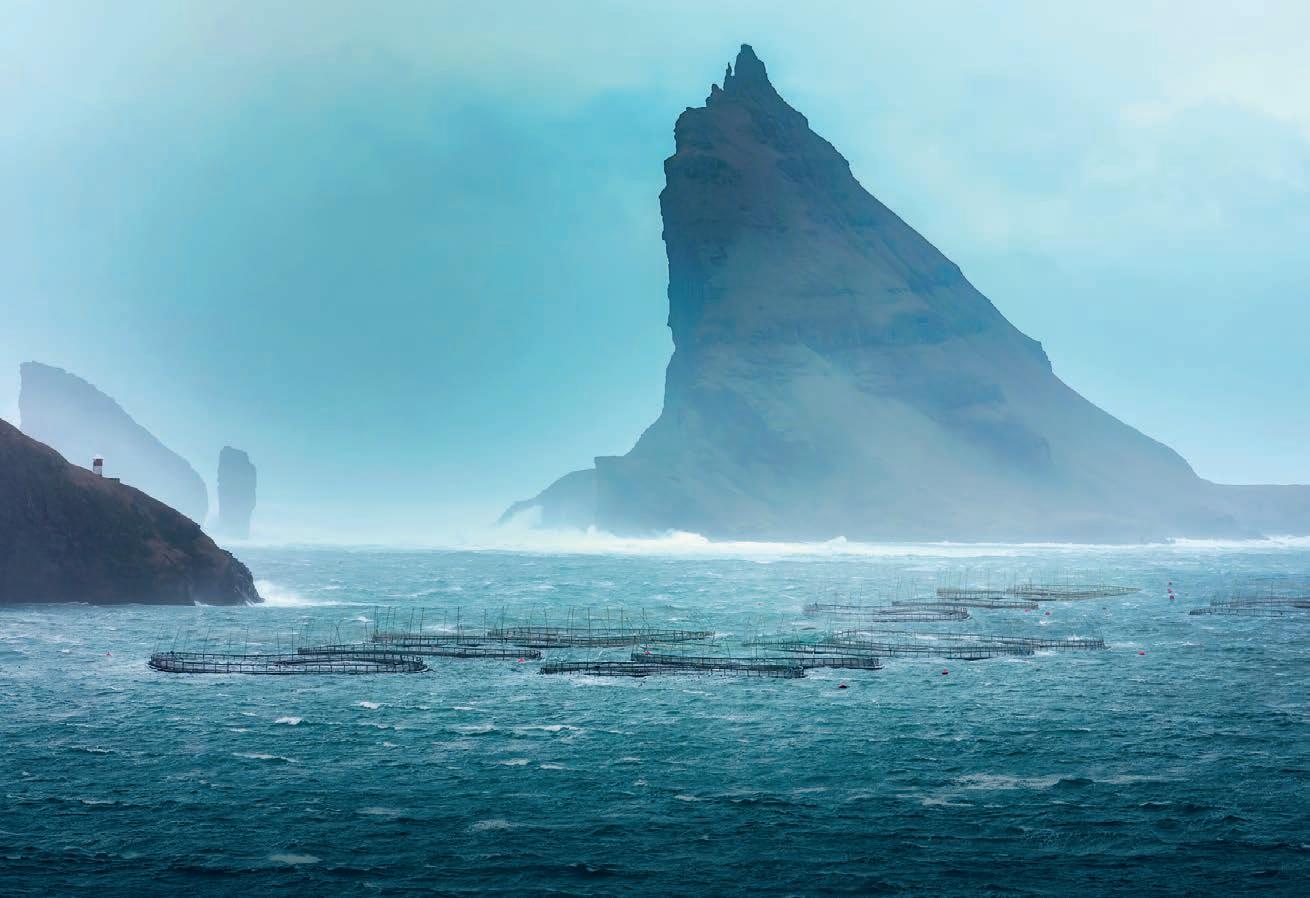






















A SEAFOOD cooperative representing Scottish shellfish producers was named as Supplier of the Year in the Marine Stewardship Council awards, held recently in Plymouth.
Scottish Shellfish Marketing Group (SSMG) won the coveted title of MSC Supplier of the Year, an award for which it was nominated by its customers, in recognition of the organisation’s commitment to responsible sourcing.
The MSC and ASC UK 2024 Awards were held jointly and sponsored by Seafood Scotland, Plymouth Gin and Plymouth City Council.

The ASC awards saw accolades for Fish Said Fred, Sainsbury’s and Lyons Seafood.
SSMG mussel farms have been MSC accredited for more than 12 years.This year SSMG was also the first producer to be accredited ASC certification for Scottish farmed Pacific oysters.
Derek Sharp, Commercial Manager, Scottish Shellfish, said, “We’re really proud that SSMG won Supplier of the Year especially as this award was nominated by our customers. It was great to be able to celebrate with them and share in our success.”
Scottish Shellfish Marketing Group is a co-operative with 15
members, supplying MSC Mussels to supermarkets and foodservice operators throughout the UK and promoting the nutritional and taste benefits of eating Scottish seafood. The winners of the MSC awards, in full, were:
MSC UK Supermarket of the Year: Gold –Sainsbury’s; Silver – Iceland; and Bronze – Lidl
MSC UK Retail Supplier of the Year – Scottish Shellfish Marketing Group
MSC UK Seafood Brand of the Year – Princes
UK Online Brand of the Year – Ocado
MSC UK Marketing Champion of the Year – Lidl.
MSC UK Marketing Campaign of the Year - Birds Eye & Iceland, for Big Sea Savings
MSC UK Foodservice Supplier of the Year – Brakes and M&JSysco companies
MSC UK Foodservice Champion of the Year 2024 – Lussmanns
MSC UK Ocean Leadership Award 2024 – Cornish Sardine
Management Association
MSC UK Fishing Hero of the Year 2024 - Ian Syvret, Jersey
Lobster Fishery
MSC UK Newcomer of the Year 2024 – Crosta & Mollica.
A COMMITTEE of MSPs in the Scottish Parliament has warned that the scientific work that underpins fisheries policy could be adversely affected by underfunding, especially for the Marine Directorate’s research facilities.
The Rural Affairs and Islands (RAI) Committee has written to Mairi Gougeon, Cabinet Secretary for Rural Affairs, Land Reform and Islands, following its review of the

Marine Directorate budget, as part of its Pre Budget Review.
Committee members visited the Directorate’s Science Laboratory in Aberdeen (pictured) as part of its review. In the letter, RAI Convener Finlay Carson says: “It was clear that the staff we met were dedicated and professional...the condition of the marine laboratories estate, however, was far from ideal as a result of recent weather events and the age and condition of some buildings, and members were concerned about the impact the condition of the laboratory facilities was having on scientists’ ability to work as effectively as possible. For example, samples need to be stored at an appropriate temperature and scientists need to have a dedicated and sufficient work space.”
One building previously used by the
TWO directors have stepped down from the board of marine technology business OTAQ, as part of an initiative to save money at the company.
Harald Rotsch has stepped down from the board but will continue to act as Chief Technology Officer in a non-board capacity, while Sarah Stoten has resigned her position as NonExecutive Director, both as of 31 October.
In a statement, OTAQ said: “Both Harald and Sarah have voluntarily resigned their positions in recognition of the costcutting measures already implemented by the company, measures which they view appropriate to extend to all levels.
“While Harald will remain with the company, Sarah has kindly offered to support a smooth transition. It is the board’s view that it will retain the expertise needed to service the nearterm needs of the group, best positioning OTAQ for long-term success and
Directorate was currently empty because it had been found to contain asbestos, while another had been damaged by Storm Arwen in 2021 and has still not been repaired.
RAI Convener Finlay Carson told Fish Farmer: “We were quite shocked at the working conditions the Directorate staff were facing.” Overall, the committee found, funding levels have declined following the formation of Marine Scotland in 2009 from £75.5m in 200910 (£108.3m real terms) to £45.8m in 2016-17 (£58.5m real terms).
At the committee’s hearings, a number of experts expressed concern that the high reputation of marine science in Scotland was being undermined by funding cuts and by a focus on compliance work over research.
The committee says it will return to this issue when the 2025-26 budget is published.
maintaining suitable corporate governance.”
OTAQ reported an operating loss of £422,000 for the first half of this year.The Scottish Government’s decision to impose a de facto moratorium on acoustic deterrent devices (ADDs) was a blow for the company’s Sealfence offering, but with new product lines such as the Live Plankton Analysis System (LPAS) and the investment in shrimp biomass business Minnowtech, OTAQ sees opportunities to develop other markets.

Phil Newby, Chief Executive Officer, commented: “I would like to sincerely thank both Harry and Sarah for their valuable contributions to OTAQ during their tenure on the board.We are pleased that Harry will continue in his current role and we will retain his extensive expertise and industry knowledge within OTAQ. I also extend our best wishes to Sarah in her future endeavours and thank her for continued support as we transition to a leaner business and establish a solid platform from which we can then grow."
THE Oyster Restoration Company is to donate native oyster spat to support the restoration of marine ecosystems in Scotland’s Cromarty Firth.
The project takes the form of a partnership with “rewilding” campaign organisation Mossy Earth, as part of the latter’s Donate and Collaborate Initiative.
Mossy Earth is looking to reintroduce native oysters and enhance sea rass ea o s in t e firt s surroun in t e lack sle ere once widespread reefs are now considered absent.
European Native oysters (Ostrea edulis) are vital to maintaining the health and biodiversity of marine ecosystems, acting as natural ater filters an creatin a itats t at support a variet o arine li e o ever ue to actors suc as overfis in a itat loss and disease, native oyster populations have plummeted by more than 95% in the last century. Mossy Earth’s Cromarty Seascape project aims to help reverse these losses by restoring oyster reefs in the Cromarty Firth and re-establishing this keystone species in its natural environment.
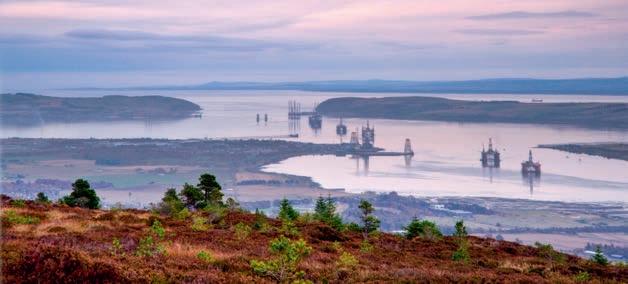


BIOMAR UK has become the first feed mill in the UK to gain certification under the Aquaculture Stewardship Council’s new feed standard.
The ASC said certification for BioMar’s Grangemouth facility –which produces feed for salmon and trout – marks a significant milestone for the company but also for the progress of the entire UK farmed seafood industry towards more responsible practices.
Salmon and trout farms in the region and beyond are now able to obtain ASC compliant feed from BioMar UK.
It is only the second feed mill to attain ASC Feed Certification in Europe and, the ASC said, will play a pivotal role in ensuring more responsible production of feed for the Scottish salmon industry, where transparency, responsibility and traceability are increasingly important.
Rob Wilson, BioMar UK Business Unit Director, said:

“Achieving ASC Feed Certification at our Grangemouth facility marks an important step for BioMar UK. This milestone highlights our commitment to leading the charge in responsible aquaculture practices.
“By providing ASC compliant feed, we are not only supporting local salmon and trout farmers but also helping to ensure that the UK aquaculture industry continues to meet the growing demand for ethical and transparent seafood production.”
ASC certified farms have until October 2025 to change their feed supply to be ASC compliant – in other words, to use only feed produced by certified mills.



EUROPE’S shellfish industry has the potential to solve many ey policy challenges but the industry itself is in crisis .That was the warning last wee from the uropean ollusc roducers ssociation ( ), which held its first event in the uropean arliament in trasbourg.
The uropean ollusc roducers ssociation ( ) brings together national or regional associations and bodies representing mollusc producers within the uropean nion and the .
ith members from si uropean countries pain, rance, the nited ingdom, the etherlands, taly and reland the represents 0 of the companies or operators involved in the production and mar eting of shellfish in urope.The is currently chaired by ddy isseeuw from the etherland roducers ssociation.
The presented its manifesto for the sustainable development of the uropean shellfish sector, which among other things calls for the space allocated to shellfish farming to be tripled and for improvements in water uality.
The manifesto s last point calls for the creation of an ommon uaculture olicy setting binding ob ectives and measurable development indicators as the only way to reverse the downward trend in production and unloc the full potential of the s shellfish sector.
The mollusc producers are calling for the strict implementation of the environmental regulations related to wastewater treatments and water management, for political support for the sector s development, and for the valorisation and compensation of the ecosystem services provided by the sector.
profession that contributes to the ob ectives of food autonomy. sector of activity that creates obs. ey player in the sustainability of our environment, acting as nitrogen sin s or a means to combat coastal erosion, e plained rench ember of the uropean arliament sabelle e allennec who was hosting the trasbourg event
The ambitions of the uropean nion for a uaculture are as bold as they are necessary, declared ddy isseeuw, resident, in his speech.
e added The envisions a future where sustainable a uaculture plays a pivotal role in food security, environmental sustainability and economic resilience. nfortunately, the reality on the ground is very different. ot only the sector is not growing we are decreasing year after year.
ollusc production is the largest segment of a uaculture in the , with an annual production of over 500 million tonnes. t uropean level, the shellfish production sector represents an annual production worth €11 0m ( £ 1m) and more than 50 of a uaculture production. owever, this ey player in the a uaculture industry has been in steady decline for 20 years.
JAPAN’S Mitsubishi Corporation has bought into the Finnish aquaculture technology company Finnforel.
Mitsubishi, a large conglomerate with a range of industrial interests, already owns the salmon farming group Cermaq, which operates in Norway, Chile, Scotland and Canada. The amount it has invested in Finnforel has not been disclosed.
Finnforel is an innovative agritech company, focused on farming rainbow trout in what it says is a sustainable way. It has pioneered a comprehensive concept which encompasses the entire value chain—from advanced selective breeding programmes to its feed, farming, processing, packaging and branding of its fish products.
Finnforel said the aim of the Mitsubishi investment is to secure “a sustainable, efficient, and environmentally friendly way to produce fish locally which will offer also significant benefits to food security”.
Finnforel’s strategy is built around its unique Gigafactory concept, which integrates environmentally friendly fish farming and processing under one roof, delivering industrialscale production with maximum efficiency and sustainability.
The announcement explained:
“Through this investment from Mitsubishi Corporation, Finnforel will develop their farming of rainbow trout, which is a suitable coldwater fish species for recirculating aquaculture systems (RAS).
“These systems employ advanced biofiltration to allow control of all essential environmental factors and ensure stable, safe and clean indoor
conditions, while efficiently recirculating and reusing water within a closed system, ensuring zero biowaste and minimum wastewater.
“The usage of recirculating aquaculture systems facilitates year-round fish production, irrespective of environmental conditions.”
Finnforel’s Gigafactory concept also covers processing and packaging of consumer fish products onsite.
Its solution allows it to minimise the number of parties involved in the logistic chain and cut transportation time.
“This will naturally guarantee ultimate freshness of fish products delivered to consumers and lowers the cost,” the company added.
The concept also supports local food systems and reduces the carbon footprint associated with long-distance transport, Finnforel said.

Pekka A Viljakainen, Co-Founder and Chief Executive Officer of Finnforel Group, said: “I believe that in future, RAS will play a crucial role in enhancing food security by enabling efficient, sustainable, and reliable production of fish where excess nutrition and waste will not end up in the seas. That is why we developed our Finnforel Gigafactory with 0% waste policy, to be implemented where the consumers are. We are very proud to have Mitsubishi, with its global distribution channels, talent and resources, to support Finnforel’s journey.”
BAKKAFROST has unveiled weaker than expected third quarter results. Meanwhile, the company’s Scottish arm continues to ake a loss ut t e latest fi ures s o its recover is continuin
C e in aco sen sai luntl t at e as not satisfie it t e roup s results t is uarter e aroese-o ne sal on ar er announce a lo er roup or operational profit or t e ul to Septe er perio o 173 million Danish kroner (£19m) compared with DKK 269m (£30m) 12 months earlier.
Bakkafrost Scotland produced revenues of DKK 317m (£35m) up ro in Q last ear e operatin loss or EBIT was almost halved – down from minus DKK 263 million (-£29m) to minus 138m (- £15m ) this time.
The Faroe Islands produced revenues of DKK 1,420 million (£159m) down from DKK 1,628m (£182m) last year an a lo er operational or profit of DKK 310m (£34m) which was DKK 232m or £26m lower than Q3 2023.
C aco sen tol s are ol ers t at the results were mainly impacted by low salmon prices and the continued aftere ects o t e eneral strike in t e aroe Islands in May, as well as an unplanned cull forced by a disease issue at one of its sites.
He said: “The strike in May combined with the unplanned harvest of A-19
i pacte ne ativel our a ilit to a apt to arket nee s to optimise market value for our products.”
ut e stresse it as not all loo n t e aroe slan s e ave seen ver oo iolo ical per or ance is is evi ent in t e stron ro t lo ortalit an increase arvest ei ts
“Our hatcheries have also delivered excellent operational results ena lin us to increase our s olt trans er e pectations for this year, with further increases planned for next year.”
urnin to Scotlan aco sen sai ur e-riskin strate as worked. Exceptional mortalities have reduced by more than 80% co pare to last ear arvest ei ts ave increase an sea lice levels are at an all-time low - just like in the Faroes.

Regin Jacobsen
e are akin stea pro ress in ra pin up pro uction at the Applecross hatchery to produce lar e i - ualit s olt an e pect start trans er o s olt in Q
Hereafter, we expect to only transfer i - ualit s olt a ove
e a e o aintain a stron co petitive position e are prioritisin cost ana e ent an ali nin our capacity with operational needs. In line with this, we have implemented several cost-savin easures an capacit a ust ents in Scotlan inclu in t e closure o t e processin acilit at ar ank in ul e ull e ects o these measures were not visible in Q3.”






THE third edition of the international aquaculture industry show, Aquafuture Spain, will take place from May 20 to 22, 2025, at the IFEVI exhibition centre in Vigo, in the north-west of Spain’s Atlantic coast. After two successful editions in Silleda, next year’s event looks set to be bigger than ever, with the confirmation of 1 0 e hibitors, a 20 growth compared to the previous edition, with seven months to go before it takes place. Aquafuture Spain is the only aquaculture show in Spain and the second largest in Europe. For more information, go online to aquafuturespain.com.
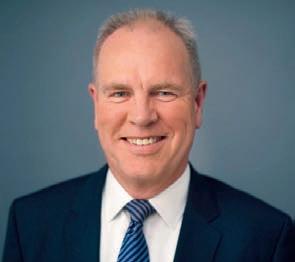
OLE-Eirik Lerøy, Mowi’s longserving Chairman, is stepping down from the board of the salmon farming giant after more than 15 years. His successor
will be shipping executive Ørjan Svanevik. Ole-Eirik Lerøy (pictured) joined the company in 2009 when it was known as Marine Harvest. Over the last 15 years, the business now known as Mowi has developed into the world’s largest producer of Atlantic salmon with a turnover of €5.5 billion (£4.6bn).
John Fredriksen, Mowi’s largest shareholder, said: “Ole-Eirik is a true industry veteran... we highly appreciate his contributions over the past 15 years.”
Communities receive record £331m from salmon fund
THE Norwegian seafood sector produced its best ever export results in October – with salmon continuing to dominate and also netting the highest ever value.
The total for the month was O 1 .5bn (£1.3bn) 5 or NOK 914m (£64m) up on 12 months ago.
Christian Chramer, CEO of the Norwegian Seafood Council, said: “Never before has seafood been exported for a higher value in a single month.
“The reason is primarily an exceptionally strong mackerel export that we have not seen the likes of. It alone accounts for almost the entire increase in value in October.” So far this year, Norway has exported NOK 143.1bn (£10bn) worth of seafood. This is an increase of O 1. bn, (£100m) or 1 compared to the same period last year.
Measured in US dollars, the value is unchanged, while in euros the e port value was 1 lower.
CEO Chramer added: “The economic development in the markets appears to be moving in a positive direction, with record low
unemployment, real wage growth and prospects for increasing household consumption in the EU. “These are factors that increase purchasing power and thus the willingness to pay for Norwegian seafood.”
As usual, salmon continues to dominate the Norwegian seafood scene with exports of the popular pin fish hitting a new pea during October.
Trends also appear to be changing with a continued marked growth in the sale of salmon fillets last month.
The country’s salmon farmers sold 144,761 tonnes worth O 12bn (£ 2m) last month. The value was up by NOK 133 million (£ m) with a 10 growth in volume. Poland, the US and the Netherlands were the main salmon markets.
Seafood Council analyst Paul T andahl said The growth in fillet exports is a trend we have seen throughout the year. It must be seen in the context of increased processing capacity in Norway.”
He added: “In October, the USA was the biggest growth market for both fresh and fro en fillets.
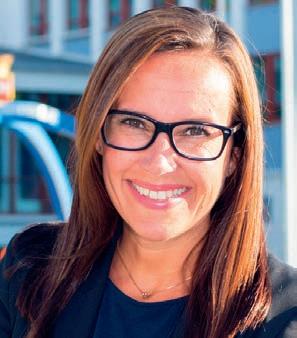
NORWAY’S Aquaculture Fund looks set to pay out NOK 4.7bn – £331m – this year to coastal communities. The payment is the largest since the fund was set up and is due to the exceptional prices paid at auction for fish farming licences. Fisheries and Oceans Minister Marianne Sivertsen Næss (pictured) said the coalition government was also ensuring that the host local authority areas should receive a larger share of the value creation from the fish farming industry. She added: “The government has always said that the host municipalities should come out better after we introduced land rent tax on aquaculture. The result is that the municipalities get more money to offer welfare services for their residents.”


SAMHERJI, celan s lar est fis in an a uaculture co pan is to start ork on its ne sal on lan ar t is ont e ne s as isclose t e co pan s C air an al vin orsteinsson at a eloitte ariti e in ustr event t is eek e escri e t e pro ect at e k anes near t e celan ic capital e k avik as t e roup s i est sin le pro ect e s ovel cere on or t e first p ase o t e fis ar ic ill e uilt over a nu er o sta es ill take place on ove er
e ar ic receive roa support ro pu lic in t e area last ear is e pecte to eventuall pro uce tonnes o fis a ear t ill also create at least ull ti e o s e c air an sai t at sal on consu ption aroun t e orl as ro in an t is as presentin e citin opportunities e see t at our custo ers ant a i e ran e o sal on pro ucts an sal on as no eco e t e i est pro uct in ost countries
e total invest ent ic inclu es a ne po er plant is t ou t to e ell over
ICELANDIC salmon farming company Arnarlax has been told that its licence to farm 10,000 tonnes of sterile salmon in Isafjord has been revoked.
The reason given by the Icelandic Environmental and Natural Resources Board of Appeal was that MAST, the Icelandic Food and Veterinary Authority, failed to provide a “comprehensive, weighted assessment of the potential risk of the spread of fish diseases and parasites” before issuing the licences.
The ruling is a big setback for Arnarlax, which is the production division of Icelandic Salmon and which in turn is majority owned by the Norwegian salmon farmer SalMar.
Arnarlax CEO Bjørn Hembre said that as a consequence, the licence,

which was originally awarded on 14 June this year, has been revoked.The Board of Appeal also addressed the issue of maritime safety.
He added: “This [decision] is unfortunate but will not affect our long-term guidance for production of fertile salmon on current licences. We are now going over the ruling and will work with MAST on the next steps.”
Arnarlax said that according to the ruling, such assessment of potential risk is a necessary precondition for licences in areas where the distance between fish farming sites is less than five ilometres.
The Board of Appeal also addressed maritime safety issues concerning one of the three sites. Arnarlax will work with authorities and MAST on these matters and perform the necessary assessment in order for the licence to be reissued.
The company added: “Icelandic Salmon want to emphasise that no fish farming operations have started in Ísafjarðardjúp and therefore, the ruling will have no effect on current operations or guidance.”

















































NORWEGIAN salmon farmer Måsøval issued a results warning ahead of its third quarter report due later this month.
It has blamed biological issues and most notably high salmon lice levels, which is currently affecting several companies, for the problem.
It is also reducing its harvest guidance for this year from 26,500 to 27,500 tonnes down to 24,700 to 25,700 tonnes.
Måsøval says the operational result is weaker than expected by the market and preliminary estimates by analysts covering the company’s share.
The statement added: “Although Måsøval does not provide financial guiding apart from harvest volume and a general indication of cost development, the company finds a notification is required as it is deemed as inside information in the view of the company and a profit warning is warranted to ensure investors are well informed.
“Operational results are weaker due to accelerated harvesting of two sites with ISA [infectious salmon anaemia], at Måøydraga and Espnestaren.”
Måsøval said challenging logistics and more expensive harvesting of salmon with ISA, in addition to low average weights resulted in high costs and low prices for harvested volume.
The harvesting of the sites with ISA (Måøydraga and Espnestaren) was finalised during the quarter.
The statement continued: “Sales and processing segment had a negative effect on the operational results due to one-time costs in order to make the new harvesting plant TL52 operational.
“The plant was operational from September 3 2024, and had a faster ramp up of volume than expected. The company has also experienced substantially higher sea lice pressure, compared to what is seasonally normal in the region, and what was expected at the time of the Q2 presentation.
“More treatments of sea lice have hampered production resulting in a negative revision of harvest guiding for 2024.“
Måsøval said it is still finalising its Q3 report, which is expected on 19 November.


NORDIC Halibut has reported third quarter sales prices for its premium farmed fish up 11 year-on-year, continuing the rise seen earlier this year.
In its Q3 (July to September) operational update, the company said the increase was consistent across size categories compared to the same quarter last year and demonstrates the strong demand for halibut and willingness to pay for quality farmed halibut.
In Q3 2024, it achieved an average sales price of 1 3 O g O (head on, gutted), or around £11. 5.
Nordic Halibut is based in Averøy, central
Norway. It also achieved an increase in average harvest weights, to . g O compared to 3 2023 s average of .3 g O .
Nordic Halibut is prioritising the harvest of smaller individuals to optimise the size distribution of the existing biomass with the ambition to increase average harvest weight over time.This cull of smaller fish is e pected to lead to further improvements in price achievement.
Total revenue for 3 202 amounted to O 1 m (£1.2m) with harvest volumes reaching 10 tonnes O .
It added: “The strategy to harvest smaller individuals to prioritise the growth and e ibility of the biomass at sea is yielding strong results.
This is demonstrated by a 1 biomass growth during the quarter, net of harvest compared to Q2 2024. Including the harvested amount, this represents total production at sea of 21 of outstanding biomass during the uarter.
“This focus aligns with the commercial strategy aimed at increasing harvest weights in future periods to respond to mar et signals. The overarching objective remains to optimise the utilisation of available biomass, even if it entails potential impacts on short-term harvest volumes.”

NORWAY’S rapidly growing cod farming industry has received its first dedicated wellboat. Watched by several hundred people, leading cod farming company Ode “christened” the Ronja Ode at its anse aia head uarters in the centre of Ålesund in October.
The event mar ed the beginning of a uni ue collaboration between the two local companies, Ode and the wellboat company Sølvtrans. Ronja Ode (pictured) is the world s first dedicated wellboat for transporting farmed cod and represents a significant step forward in the development of the cod farming industry.
The companies said this partnership demonstrates how local companies from the unnm re region are leading the global mar et for aquaculture solutions.
Ode O Ola valheim said This collaboration between Sølvtrans and Ode is a great example of how local companies along
the coast are world leaders in aquaculture and a uaculture solutions, wor ing closely together to achieve their goals.
“Ronja Ode, as the first wellboat dedicated to cod, will be an excellent addition to our integrated value chain. “
Christian Remøy, Head of Cod Operations at Sølvtrans, shared the excitement. He said: “Sølvtrans is very pleased that two local companies, Ode and Sølvtrans, have started a long and important collaboration in the transport of farmed cod.
“We see cod farming as an innovative and future-oriented industry. The crew and shipping company have wor ed hard over the past si months to prepare the world s first dedicated wellboat for cod. “
He added: “Sølvtrans hopes Ronja Ode will ma e a significant contribution to Ode delivering a top uality product to the mar et.
A LARGE number of people at the companies behind the “Egg” close contain ent fis ar s ste look set to lose t eir o s
So e involve in t e also kno n as ett s ste are ein a e re un ant ile ot ers are likel to e stoo o n at least te poraril at ot t e or e ian tec nolo co pan vu an t e pro uction co pan er e o positt ccor in to t e local ne spaper Bergens Tidende, t e ointl operate usinesses e plo ust over people Cato n oun er an eneral ana er o vu tol t e paper t at sales a not reac e e pectations e co pan a ope to sell t o etts t is ear to t e sal on ar in sector eac o etres capacit at as not appene an investors appear to e currentl sittin on t e ence e on its i pressive appearance t e ett as aile as a reakt rou in t e fi t a ainst sal on lice an in ections e pro ect as first unveile ore t an nine ears a o it t e clai t at it ill elp fis el are

e ca e takes in ater ro the bottom of the structure and pumps it out through the top e environ ent an pro uction can e controlle
o i as one o t e earl investors but it has since sold its interest in t e pro ect
LARGE bluefin tuna brea ing into salmon cages have been causing serious disruption at a number of orwegian fish farms.
hile the problem is not on the same scale or of the same severity as ellyfish attac s, the tuna also nown in orway as mac erel sturgeon have nevertheless created uite a headache and a lot of e tra wor for the affected farms. our incidents were recorded during October and at least three more in the preceding few months. owi was one company affected while the farming company ulefis spent at least four days trying to free a 3 ilo ( 0lbs) tuna.They finally succeeded than s to help from


divers and underwater vehicles. ome of these fish are particularly large and powerful, often the si e of a small shar .They can cause a lot of damaged as they try to brea into the cages.
The attac s appear to come mainly from the species nown as eastern mac erel sturgeon which spawn in the editerranean.
The veterinary authorities say there has been an increase in the number of tuna moving into orwegian waters during the late summer and early autumn months, where they gra e intensively in the coastal waters in which the farms are located.
The authorities say that overall, more and more tuna are being observed over large areas from the orth ea right up to the southern tip of valbard.
The orwegian irectorate of isheries has issued a guidance list to salmon companies on how to handle the tuna if they do get into a cage, including the advice that entry holes must be repaired as soon as possible once the tuna is out.

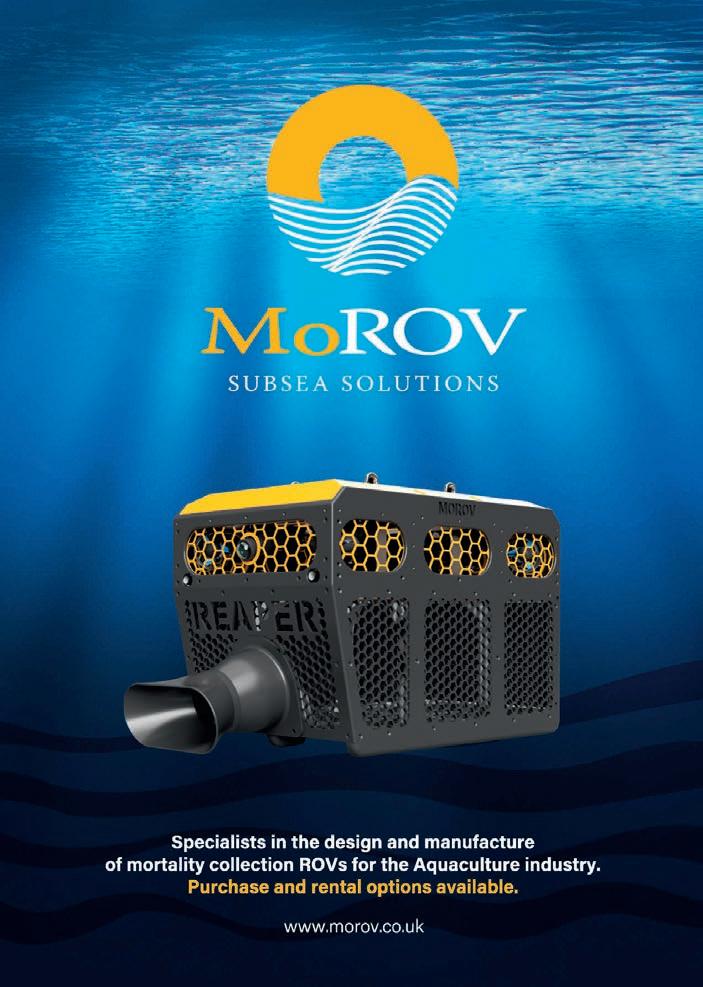
A GROUP of activists in Australia have failed to stop the large Woolworth retail chain in Australia selling Tasmanian salmon.
They claim that salmon farming practices in Tasmania’s Macquarie Harbour are threatening the rare Maugean skate which now only exists in that area.
Marine biologists estimate that fewer than 200 of the skate remain and their future existence as a species remains in serious doubt.
The campaign is being led by a group of 120 marine activists who say that salmon farming is a major threat to the future existence of this prehistoric fish. hareholders at the oolworth annual general meeting in ydney were asked to vote on a resolution calling on the company to no longer sell salmon from the harbour from next year, but they rejected the demand – at least for the time being.

company. It did, however, take the name from the original company, which had not been registered in Australia at the time.
oolworth roup chairman cott Perkins told the AGM the company was waiting for the results of government studies before making a further decision about sourcing farmed salmon from Macquarie Harbour, which produces about 10,000 tons of salmon a year.
owever, a ban on salmon fishing has not been totally ruled out by the retailer.
Despite its name, the Woolworth shops have no historical connection with the famous FW Woolworth store chain that once operated in the and UK. The similarly named Woolworths supermarkets in Australia (and later New Zealand) are operated by a separate
“The unsustainability of supply from Macquarie Harbour is a matter we’re taking very seriously,” he said.
The condition of this rare skate species is currently being assessed by the Australian federal government.
Last week the industry body, almon Tasmania, e pressed concern that ustralia s Threatened pecies
Conservation Committee had been granted an extension to 30 October 2025 to come up with its recommendations on the Macquarie Harbour issue. This means that the future of the Tasmanian salmon industry will not be decided until after Australia’s next federal elections.
u e artin, O, almon Tasmania, said: “We are frustrated but not surprised by this outcome.
There has now been a ood of scientific evidence presented to the Threatened pecies onservation Committee showing the situation for the skate is very different to some of the initial advice they had been reviewing.
“Macquarie Harbour is the healthiest it’s been in over a decade and the captive breeding programme is proving an early success. On top of that, the population sampling that informed that committee’s initial thinking has now been proven to be very awed.
“Everyone is determined to secure the future of the Maugean skate, but decisions must be grounded in accurate information on the population numbers and the many potential reasons for the species’ long term decline.”
THE Ecuador site of aquafeed group BioMar has achieved certification under the Aquaculture Stewardship Council’s new international Feed Standard.
Located in Guayaquil, BioMar’s facility produces highquality shrimp feed. The company said that achieving ASC Feed certification is a key part of BioMar’s broader strategy of sustainable innovation and strengthens its role as a trusted provider of ASC compliant feed.
Henrik Aarestrup, Vice President for Latin America, Shrimp & Hatchery, at BioMar Group, commented: “Our goal is to provide shrimp farmers with the tools they need to succeed in a rapidly evolving industry. With this certification, our customers can be confident that they are using feed that meets the highest global standards for sustainability, helping them to secure their position in a fast-growing market.”
He added: “For us, this certification goes beyond meeting a standard. It’s part of our broader commitment to supporting the entire shrimp aquaculture value chain. By investing in innovation, sustainability and collaboration, we aim to help farmers achieve long-term success while ensuring that seafood production is ethical, transparent and sustainable.”
ASC CEO Chris Ninnes said, “Our ASC Feed Standard establishes an essential and unique benchmark for feed production and BioMar’s certification in Ecuador is a welcome development towards greater transparency,
traceability and impact measurement in the feed industry. We congratulate them on this achievement and their ongoing commitment to more responsible feed.
“With the first feed mills celebrating ASC certification in January 2024, we started a journey to drive positive change in the feed industry. There is still much more progress to be made, but with the commitment of the seafood farming sector and the entire value chain, we now have over 30 feed mills either certified or in assessment. That collaborative effort will truly transform global aquatic feed production towards greater responsibility.”
ASC-certified farms have until October 2025 to ensure their feed supply is ASC compliant. The use of ASC compliant feed is necessary for ASC certified farms to continue meeting the ASC Farm Standard and retain their certification.

farm loo s set to be built in the heart of anada with official help and approval.
The anitoba provincial government has promised support for the apphire prings nc rctic char a uaculture and processing facility near oc wood unicipality, north of innipeg.
apphire prings, which is ust four years old,says the 1 5m (£ 0.5m) pro ect will create at least 100 obs plus 120 indirect obs and would help boost the local economy.
t would also be anada s most central land fish farm, with most other facilities in ritish olumbia or on the east coast.The pro ect will also be anada s largest rctic char facility.
The anitoba state has also said it is financially supporting the plan with a loan of around 10m (£5.5m).
The province s Trade and atural esources inister amie oses and
griculture inister on ostyshyn both said the facility will contribute to anitoba s economy.
amie oses highlighted the government s commitment to ob creation and economic growth, emphasising that the facility will e pand opportunities in anitoba while producing sustainable food.
The facility, located at the former site of the epartment of isheries and Oceans oc wood perimental ish atchery, will be anada s largest rctic char facility and aims to position anitoba as a leader in the industry.
en lair, O of apphire prings nc, e pressed gratitude for the province s support and outlined the company s goal of becoming a leader in sustainable a uaculture.
e stressed the pro ect s role in supporting the local economy and meeting the rising demand for healthy, sustainable protein sources.

industry coalition tronger merica Through eafood ( T ) has e pressed its strong support for the ational eafood trategy mplementation lan released by O isheries.
The plan highlights the importance of increasing sustainable a uaculture production as part of a broader strategy to strengthen the seafood industry.

T commends O isheries for prioritising sustainable a uaculture production as a ey component of its ational eafood trategy, said rue anta inters, ampaign anager of T . This plan outlines critical steps that the agency is ta ing to support growth of an merican a uaculture sector, which includes a focus on developing an efficient, predictable, timely and science based regulatory framewor for offshore fish farming in federal waters. ntil a clear and efficient regulatory permitting process is put in place, the will continue to miss out on the significant economic, environmental and food security benefits that offshore a uaculture would provide.
ey goals outlined in O s ational eafood trategy mplementation lan include
• cceleratin pro ress on i ple entin an e ficient pre icta le ti el an science- ase re ulator ra e ork or arine a uaculture by providing continued e pertise and coordination for the permitting of prospective a uaculture operations, and leading the identification of uaculture Opportunity reas ( O s), or areas that are deemed ideal for fish farms.
• Continuin to invest in a uaculture science This includes by conducting a uaculture studies to provide science based advice and tools to minimise potential negative effects of marine a uaculture operations on the environment and to support sustainable industry development.
The plan identifies four pilot initiatives around which O aims activate and enhance partnerships to tac le cross cutting issues.These initiatives include efforts to bolster industry resilience in the ulf of e ico and outh tlantic shrimp fishery support revitalisation of the port of ort Orford, Oregon increase climate resilience in highly migratory species fisheries and support las a s seafood sector resilience.
SENIOR figures in ew ealand s a uaculture industry are warning that red tape and lac of access to ey areas of the coastline are seriously hindering growth.
oncerns over bureaucracy and other issues were e pressed at the recent uaculture ew ealand conference in elson, at which the view was e pressed that it is becoming increasingly difficult to get access to the sea.
ing almon hief ecutive arl
arrington said that while opportunities to e pand the a uaculture sector were huge, only 0.01 of the country s large marine economic estate was currently being farmed.
ccording to adio ew ealand ( ) he maintained s a nation, we have made it incredibly difficult to gain access to farm the sea.
e said the company s lue ndeavour pro ect to farm salmon in the oo trait was the poster child for this, having ta en nine years and m (£ .2m) to get through the consenting process.
arrington reminded his audience that the

industry generated 0m (£355m) revenue each year from the farming of mussel, salmon and oysters (three uarters of which was e port earnings) which was but a drop in the ocean of the potential .
e went on almon generates a return 1 ,000 times greater than sheep and beef per surface hectare.
nfortunately the salmon sector s production has moved diddly s uat in the last 10 years. said lue ndeavour is e pected to be a
ma or contributor to the industry s 3bn (£1. bn) goal, where it is hoped 10,000 tonnes of salmon will be produced at the 12 hectare farm each year. t should be worth an estimated 350m (£1 3m) in e port earnings, which would more than double the company s current production.
ts pilot farm, made up of two 55 metre diameter pens, is e pected to be operational from the middle of ne t year, with salmon to be harvested from 2030.
arrington said the government had ta en steps to reduce regulatory hurdles and he presented inister for Oceans and isheries hane ones with the ing almon ommercial Thin ing elt which is awarded to an individual showing outstanding grit, ingenuity in cutting costs or creating value for our company .
e said the minister s wor had already saved the company close to 2m (£ 3 ,000) and avoided the diversion of significant resources and energy ust to maintain its current rights to operate.
ealand s aroa ing almon has become the first ing salmon producer globally to adopt the innovative lue mpact feed programme developed by io ar.
This initiative supplements wild caught fish in its formulations with cultivated algal oil, fish trimmings and insect meal.
The new approach, io ar said, significantly reduces the impact on wild fish stoc s while utilising clean, sustainable sources of Omega 3 to produce the healthiest fish possible.
s an early adopter of this technology, aroa almon trialled the algal oil, achieving outstanding results with their salmon that led to them winning the eafood uture daptation award in 2023. uilding on this success, the company s partnership with io ar now includes using novel ingredients li e insect meal and fish trimmings sourced from pelagic fish in their feed.
This initiative will see aroa ing almon become a net positive fish producer, committed to lowering its carbon footprint while incorporating regenerative and circular feed ingredients.
aroa ing almon is a 100 ew ealand owned partnership that includes gāti orou, Ōnu u unanga the indigenous mana moana (or guardians) of aroa arbour and the founding ates amily.
The company says its operations are based on intergenerational sustainability, aiming to provide local employment and healthy seafood for today and the future.

TILAPIA producer Regal Springs, salmon farmer Cermaq and retail giants Marks & Spencer and Albert Heijn were among the winners at the Good Farm Animal Welfare Awards (GFAWA) in Paris last month.
e a ar s oste not- or-profit or anisation Co passion in World Farming, recognised 49 winners from over 15 countries for their leadership in improving farm animal welfare and promoting more sustainable supply chains.

uncan ates, founder and managing partner of aroa ing almon, said hen first started farming salmon in aroa arbour, almost four decades ago, the feed ingredients essentially relied on wild caught fish as the raw material, and we fed up to 3 g of wild fish to grow 1 g of farmed salmon. learly, this wasn t a sustainable practice. ith the introduction of lue mpact, we at aroa ing almon have started our ourney to become a positive fish protein producer, a far cry from those days long ago and a testament to our ongoing aspiration to become a truly sustainable food producer.
SOME uncertainty in the aquafeed industry has been relieved with the announcement that eru s ne t fishing season will start on 1 ovember, with a quota of just over 2.5 million tonnes.
The announcement was made at the annual conference of the marine ingredients organisation O, held in isbon over 21 23 October. eru accounts for around 20 of global fishmeal supply in an average year, so the latest announcement will have an impact on the world a uafeed mar et.
The O conference gathered a record number of 530 delegates from 3 countries.
lose to 30 spea ers discussed feed ingredient strategies for the future, supply and demand for marine ingredients, feed ingredients industry beyond fishmeal and fish oil, and e plored the role which marine ingredients play in human health.



e all recognise that uality feed leads to uality food, and that s the foundation of everything we do O s irector eneral, etter ohannessen, noted. long with this contribution comes great responsibility. e must measure our impacts both environmentally and socially using science bac ed framewor s to trac progress. e ve seen e citing e amples of innovation and ambitious efforts already ta ing shape across the industry .










He added that the industry understands that its social licence to operate is essential. arning and maintaining this re uires collaboration and investment in fishery sustainability, which were ey themes throughout the conference.
Swiss-based Regal Springs received the inaugural Aquaculture nnovation ar or its co it ent to fis el are s a lo al leader in tilapia production in Indonesia, Honduras and Mexico, Regal Springs was recognised not only for its social and health initiatives that support local communities but also for its ongoing investment in research and development to promote responsible ar in practices e al Sprin s as t e first tilapia pro ucer to research, develop and implement humane electrical stunning et o s specificall or tilapia no applie across its entire production process.
Albert Heijn, the largest supermarket in the Netherlands, received a Special Recognition Award for establishing an innovative collaboration across its entire supply chain - including feed suppliers, farmers, processors, and retailers - to improve shrimp welfare.The company has effectively eliminated the practice of eyestalk ablation – used to increase egg production in breeding shrimp – reduced the stocking density and introduced electrical stunning before slaughter. Its partnership with the Shrimp Welfare Project has been instrumental in developing humane stunning solutions and setting industry standards.
A Special Recognition Award for Innovation was also awarded to British retailer Marks & Spencer. In partnership with shrimp producers and supported by FAI Farms, M&S has developed a comprehensive protocol to monitor the health and welfare of shrimp throughout its supply chain.
Salmon producer Cermaq received a Special Recognition Award for its commitment to humane stunning methods for salmon. It is the second-largest Atlantic salmon producer to adopt a global humane slaughter policy – following Mowi ASA’s commitment in 2022 – which applies to all their farms and operations in Norway, C ile an Cana a enefitin over illion sal on annuall
Dr Tracey Jones, Global Director for Food Business, Compassion in World Farming, concluded: “The geographical diversity, range o species an t e vast nu er o ani als set to enefit ro this year’s award winners are truly remarkable... it’s particularly encouraging to see innovation in aquaculture being recognised this year. Aquaculture species are sentient beings and their welfare is just as important as that of land animals. Recognition of their specific nee s is eco in ore i el ackno le e
AKVA group looks set to land the supply contract to build a planned new smolt facility for Cermaq Chile.
It is thought that Billund would get the supply deal, but the company ceased trading in the summer.
The AKVA group is the world’s largest supplier of solutions and services to the aquaculture industry.
In a brief announcement to the Oslo Stock Exchange, AKVA said: “AKVA group ASA is pleased to announce that a Letter of Intent has been awarded from Cermaq Chile SA related to a RAS contract for the new smolt facility in the Los Lagos region in Chile.
“AKVA will start with engineering and site work during Q4 2024.The value of the contract linked to the Letter of Intent is approximately €30m (£25m).The final contract is expected to be awarded from Cermaq during Q4 2024.”
Mitsubishi-owned Cermaq said earlier this year that the project,
called Nueva PCC, near the city of Paragua, will be one of its most important in the region.
It will have a production capacity of 14 million smolts per year. Cermaq Chile said the second stage of the PCC (Post-Larval Capture and Cultivation) farm will be called Canal de Chacao Fish Farm.
The fully automated project, which will be the company’s largest in Chile, includes cutting-edge technology in all its production phases, will allow the complete fish cycle to be carried out in fresh water, producing smolts from eyed eggs, with a minimum average weight of 150 grammes.


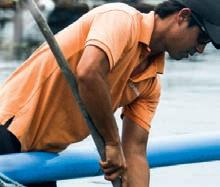


Singapore-based Barramundi Group has been given a form of insolvency protection while the company attempts to carry out financial reconstruction.

On 11 October, the fish farming group made an application to the High Court of Singapore for a “Moratorium Order” which would give it a period of six months’ protection against a winding-up order or the appointment of external administrators.
The court agreed to grant four months.
The Moratorium will also protect Barramundi against any “execution, distress or other legal process against any property of the company” unless sanctioned by the court. Barramundi, which is listed on the Oslo Børs, said: “The company requires the reliefs provided by the Moratorium Order to protect it from creditor enforcement action, while giving it breathing space to carry on negotiations for a restructuring and compromise of its debts with its creditors.”
It also announced that the group has obtained a bridging loan of SGD 400,000 (£234,000) from a shareholder. The loan, the company said, will help to finalise restructuring plans.
In September, Barramundi announced that it would be embarking on a financial reconstruction programme with the help of its financial advisor, KordaMentha Pte Ltd.
Last year the group’s Australian farms were placed into administration after ambitious expansion plans had to be abandoned. The Australian operations were subsequently sold to Tassal, a Cooke subsidiary. Barramundi is now planning to invest in sea farming, and a RAS (recirculating aquaculture system) site, in Brunei.
Meanwhile the Oslo Børs has placed the Barramundi Group in what it calls the “Recovery Box”, reserved for those companies “subject to circumstances that make pricing of the securities particularly uncertain”.




Above: (L-R) Daði Pálsson, Managing Director of Laxey; Karl Ásgeirsson, Sales Manager at Baader Iceland; and Kristmann Kristmannsson, Project Manager for Processing and Procurement in Laxey.
ICELANDIC fish farming company Laxey and Baader in Iceland have entered into an agreement for the delivery of processing equipment for Laxey’s landbased farmed salmon plant, currently under construction.
Laxey is building a new fish farm in the Westfjords region which is planned to have a production capacity of 32,000 tonnes by 2031.
For Laxey, the partnership with German-based Baader is important in
securing equipment and production technology, which the fish farmer said will support its plans for high-quality products for the global market.
Kristmann Kristmannsson, Project Manager for Processing and Procurement, said: “We are excited about this partnership with Baader, which is at the forefront of technology solutions for the marine industry.
“This agreement can lay the foundation for a successful
collaboration, and we expect that this will be the beginning of a successful relationship that will contribute to promoting the Icelandic land farming industry.”
Karl Ásgeirsson, Baader’s Sales Manager in Iceland, added: “We are proud to participate in this important project with Laxey. Our equipment will ensure that they can meet the strict demands made for quality in production in the international market.”
Laxey said Baader, a German-based global company developing and manufacturing equipment for salmon processing, is known for solutions designed with production quality and animal welfare in mind. This approach, the company said, makes Baader a good partner for Laxey which focuses on responsible food production while meeting the demands of customers around the world.
“We expect that this will be the beginning of a successful relationship ”
BEWI, a leading provider of food and seafood packaging components, is set to merge its traded food packaging business with STOK Emballage (“STOK”), forming a combined Northern European packaging solutions group.
BEWI will receive a cash consideration of €20m (£16.7m) in addition to an ownership position in the combined entity of around 15%.
Christian Bekken, CEO with BEWI, said: “Partnering with STOK presents a unique opportunity to further expand the traded food packaging business with a highly capable partner.”
BEWI’s traded food packaging business currently has net sales of approximately €75m (£62.5m).
The business has a solid position within seafood and food packaging in Norway and Iceland, with a particular focus on the seafood industry.
STOK is a leading value-added distributor of protective packaging in Denmark and Greenland and provides a one -stop solution of packaging products, machinery, logistics services, and regulatory and compliance advice.
The company has strategically located warehouses in Denmark, Greenland and Norway. The complementary combination of BEWI’s traded food packaging business and STOK creates a leading packaging distributor across Denmark, Norway, Iceland and Greenland.
STOK had sales last year of €113m (£94.2m). The new combined company will have annual sales of close to €190m
(£158.4m) and a clear strategy for further growth, said the announcement.
Christian Bekken added: “STOK is an ideal partner for our traded packaging business, and we are truly looking forward to joining forces with their team of industry experts.
“They have an impressive track record of profitable growth over several years, and their broad and diverse product portfolio complements ours very well, creating a strong potential for synergies and further growth opportunities.”


AN agreement has been reached for the purchase of the assets of the Icelandic seafood processing equipment company Skaginn 3X, which filed for bankruptcy in the summer.
A group of investors with the firm KAPP, another Icelandic technology company, will buy all the equipment and liquid assets of the Skaginn estate in Akranes.
Skaginn 3X was a well-known name in the world of seafood processing and aquaculture equipment, but it filed for bankruptcy four months ago after Baader, its German parent company since 2021, failed to turn the business around.
More than 120 staff were laid off despite attempts to save the company. Now a new company, KAPP Skaginn, has been created to move the operation forward.
Iceland’s salmon and fish processing industries are expanding
at an impressive pace and the new owners see an opportunity for Skaginn, which is majority-owned by Skaginn ehf. It will also look outside Iceland for business.
Freyr Friðriksson, KAPP’s CEO and largest shareholder, said that it could be challenging to re-hire staff but he was optimistic about the company’s future despite the fact that the market was not easy.
He said: “The market here at home and abroad is difficult, but we are certain that there are opportunities and we just have to approach them.”
He said the new operation was confident that the past knowledge and experience of staff with the previous operation along with goodwill from previous customers will prove a strong asset.
The deal is subject to approval from Iceland’s Competition Authority but the aim is to restart operations next month.
NORWEGIAN researchers are working on possible ways to eliminate Listeria food poisoning bacteria in salmon and trout.
Listeriamonocytogenesis a commonly occurring organism in the environment and it is very hard to eliminate. The DeList project, underway at Norwegian food research institution Nofima, is looking to see whether dipping a fish fillet in a bacteria-killing substance could safely reduce the threat of contamination.
Senior Researcher Tone Mari Rode, who leads the DeList research project, said: “In our experiments, we’ve used several methods that aren’t yet approved by Norwegian authorities. That’s the nature of research. If you don’t try new methods, you won’t know what works and what doesn’t.”
In the experiments, brown trout is first exposed to Listeria, then dipped in various treatment baths to determine what can remove or reduce the bacteria.
“We’ve used acetic acid, low pH, and antimicrobial – bacteria-inhibiting – substances. Nisin, which is approved in Norway for use in dairy products, is one of them,” explains Tone Mari Rode.
The project is funded by the Norwegian Seafood Research Fund, FHF.
A DISPUTE has broken out between Norway’s salmon industry and the na�onal broadcaster NRK over claims that some of its employees are developing asthma through their work.
NRK has highlighted research findings from a study carried out on workers at St Olav’s Hospital in Trondheim.
The broadcaster said reports from the hospital showed that a number of people, some of them immigrant workers, were suffering from “salmon asthma”.
One woman was so ill she thought she was having a heart a�ack. Others found themselves unable to go to work.
Doctors are con�nuing with the study, but some have described the development as “frightening” with more pa�ents appearing at clinics.
A lot of water is used in fish processing plants, leading to �ny droplets forming which the workers breath in – and this could be part of the problem, researchers suggest.
But the salmon industry employer organisa�on Seafood Norway said that an incorrect image is being portrayed. NRK chose not to say that around 15% of all asthma cases among adults can be caused by exposure in different workplaces and it does not have to involve the salmon industry.
Seafood Norway CEO Geir Ove Ystmark said: “For those who are affected by work-related asthma, it is of course sad to hear.
The aquaculture industry has par�cipated in projects related to this and to look at what can be done to prevent people from ge�ng asthma.”
Research also shows that the salmon industry could be no more exposed to this than other industries.
Ystmark added: “Occupa�ons most at risk of work-related asthma are bakers, car painters, welders, sheet metal workers, farmers, hairdressers, various industries and healthcare workers.”



THE Global Seafood Alliance (GSA) has released the latest version of its Seafood Processing Standard (SPS).
Version 6.0 includes a restructured modular framework built around core food safety requirements covering both farm-raised and wild-caught seafood, ten separate modules to accommodate the specific production processes and products at individual facilities, and enhanced data capture, reporting and assessment technologies.
Announcing the latest version, the GSA said: “This new framework was designed specifically to improve audit efficiencies, provide elevated assurances for farm-raised and wild-caught seafood to consumers, and create a more customised, comprehensive certification option for seafood processors globally.

The 10 modules in the new standard are:
• Animal Welfare – For facilities responsible for live animals and slaughter.
• Effluent Discharge – For non-remote wild processors discharging to natural water source.
• Enhanced Social – Unannounced, requires specialised social and technical audit team.
• Finished Product Testing – Requires product testing for medium to high-risk facilities
• Low Acid Canned Foods – For thermal processing and low acid canned products.
• Outsourcing – For facilities enlisting outsourced activities.
• Product Identity – For facilities making claims related to Best Aquaculture Practices (BAP) or Best Seafood Practices (BSP) certification.
• Ready to Eat – For RTE products.
• Remote Wild-Caught Environmental – For wild processors located in remote environments.
• Social Responsibility – For facilities that not electing the Enhanced Social module. The GSA will begin accepting all applications to SPS 6.0 in mid-2025 and fully replace Issue 5.1 beginning 5 November 2025.

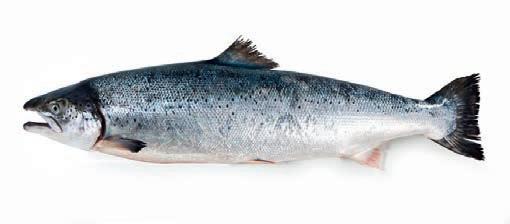
A poll, suggesting that consumers are calling for higher welfare standards in fish farming, may not be as significant as it sounds, argues Dr Martin Jaffa
• 85% - care about animal welfare
• 23% - say welfare is “important” in the buying process
• 35% - say welfare “may have some impact” in their buying decisions
• 42% - say welfare “has no impact” on their buying decisions
Source: Compassion in World Farming
IF a survey was to ask 1,000 UK consumers whether they have any issues with the salmon they buy in British supermarkets, I am almost certain that 85% of respondents would not highlight concerns over the welfare of the fish. Instead, most would probably raise the question of price or quality. Yet according to a new survey from Compassion in World Farming (CIWF), 85% of consumers believe that the welfare of fish should be protected to the same or greater extent as other farmed animals. This is not surprising given that question 4 in the survey asked: “Which of the following comes closest to your view – The welfare of fish should be protected to a greater /a lesser/ or the same extent than the welfare of other animals we eat?”
Even if consumers were not aware that salmon are farmed, the likelihood is that the majority would say that fish should be protected in the same way as other farmed animals with just a few saying either less or more. In fact, 76% said that animal welfare protection should apply equally to all farmed animals with just 9% saying fish should have greater protection. Thus, the statement that the overwhelming majority of UK citizens care about the welfare of farmed fish is somewhat questionable.
It is said that the UK is a nation of animal lovers, yet the RSPCA reported that in the first six months of 2024, they received 44,800 reports of animal cruelty in England and Wales (Scotland is not included). At the same time, it is also said that the UK is also a nation of animal killers, with fishing of salmon and trout and shooting of pheasants and grouse as well as stag hunting considered by some as cruel activities. How do CIWF square up the results of their survey with the reality of how some of the UK public treat their animals and wildlife?
Of course, the industry itself aspires to the highest possible
welfare of the fish under their care but the reality is that welfare is not the highest priority for consumers when buying their food.
The fact that the survey was commissioned by CIWF renders the results as rather meaningless because finding that 85% of consumers believe that fish should be protected from poor welfare issues is exactly the result CIWF would hope to achieve. They clearly intend to use the results of the survey to campaign for the implementation of the highest welfare standards possible although how this will relate to farming practices is unclear. According to some activists just one dead fish is perceived to be an abuse of fish welfare.
One of the other questions asked of consumers was what considerations are prioritised when buying fish. Not surprisingly, freshness, quality and price were given the highest priority, something that has never changed in the 30 years and more that I have been involved in watching the consumer market.
What was most telling about the whole survey is that whilst 85% of consumers care about welfare issues, only 23% say that welfare is important in the buying process. A further 35% said that it might have some impact whilst 42% say it has no impact at all. This confirms the saying that what people say and what people do are two totally different things.
This is also apparent from the claim that 90% of consumers would like to buy higher welfare products. In fact, they already can, but more interestingly, 18% say that they are willing to pay considerably more for higher welfare products, whilst 49% say that they would pay a little extra. A further 23% say that they want to buy higher welfare products but cannot pay any more with 10% saying that they would not pay more. However, the lack of understanding of what this means is shown by the fact that consumers have never been willing to pay a premium for any labelling whether connected to welfare, sustainability, or origin.
I mention origin because the survey found that one of the lowest priorities given to fish purchase by consumers is origin. This is relevant here because the Scotland Food & Drink’s Knowledge Bank has suggested provenance is really important to the public.
A survey of over 1,000 out-of-home diners found that 64% of respondents were likely to buy products labelled as Scottish and 42% of them were willing to pay more for Scottish produce.
”The
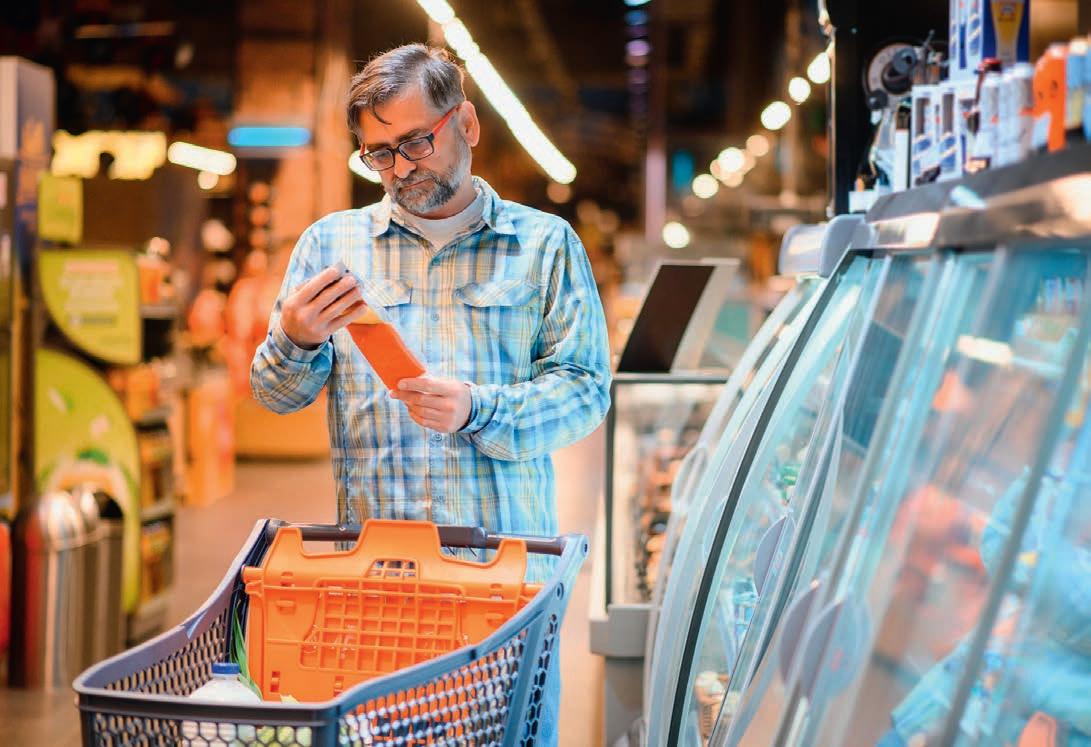
Yet, provenance is not really a priority for those who dine out. Their choice is usually the cuisine or the chef or sometimes whether a restaurant is Michelin starred. I cannot say that I have ever encountered anyone who has suggested going to eat out because the restaurant serves dishes made from ingredients with a Scottish provenance. In fact, it is not easy to find a restaurant that highlights their food as coming from Scotland.
The survey asked the diners which foods they would be willing to pay a premium price for and top of the list came Scottish lamb (74%), followed by Scottish beef (71%). There is a website for Scottish lamb with information about where to buy Scotch lamb and which restaurants have it on their menu. Most of the restaurants are in Scotland and just two are listed for London but neither identify any lamb on their menus as having a Scottish provenance.
Beef is more likely to appear on menus with a Scottish provenance, such as Boisdale in London which has a section on the menu headed Scottish beef selected for Boisdale. Interestingly, it also has a section headed Scottish pizza crisp Neapolitan sour dough base topped with the very finest ingredients from Scotland. Unsurprisingly, pizza with a Scottish provenance did not feature on the list of foods for which diners were willing to pay a premium and I suspect that diners will be hard pressed to find other restaurants serving such Scottish specialities.
For shoppers wanting to eat Scottish foods at home, provenance does take a backseat as the CIWF survey found. There is very little evidence to show that consumers will pay a premium for food with a known provenance and certainly this is the case with salmon. I am aware of packs of salmon labelled as Scottish that are more expensive to buy but typically, the cut or whether it is skin off are usually what makes salmon different and more costly.
It would be desirable if foods with a Scottish provenance did receive a premium price but sadly despite what the survey suggests, what consumers say and what consumers do are usually two very different things.

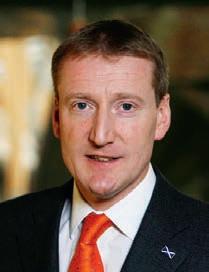

Salmon Scotland chief executive Tavish Scott reflects on the recent Responsible Seafood Summit and the ongoing debate about the impact of offshore wind on fishing





ST Andrews is a great town. Whether you are a history buff, a golfer, or want to run the West Sands in Chariots of Fire mode, there is something for everyone.
I have enjoyed visiting the Auld Grey Toon for many years due to family links, politics and, of course, the love of golf.

and British politics.


He was on a different side of the fence to me, but what I always appreciated were people of stature who could put political differences aside and talk about wider life and the economy.
Left: a al s ee e anel at t e es onsi le ea ood mmit rom le� ris ase, ea ood o r e a is o , almon otland in al M iernan, ene a les ls et Ma donald, o s is ermen s edera on Opposite: ind arm and s in essel
edera on
I watched American sporting greats Tom Watson and Jack Nicklaus cross the Swilcan Bridge for the last time and have seen Tiger Woods make the famous old links look easy.
St Andrews also hosts one of our country’s oldest universities – the alma mater of many famous people including the late Alex Salmond.
Many things are said and quoted when a notable public figure passes. Salmond had a chequered career by any standards, but was without question a highly significant figure in both Scottish
When he was First Minister, Alex Salmond came to St Andrews to speak at the
Does a government want to put at risk the British consumers’ love of a fish supper?

National Farmers’ Union Scotland annual meeting. I was a guest and after the formal proceedings, we said hello. It was not long after a bruising election where his party had done well and mine had most certainly not. But far from rubbing salt into the wound, he cheerfully talked through what was going on, the latest political news and most importantly –as he put it – would I be slipping away from the union bash to play 18 holes?
The NFU meeting on that occasion was hosted in an American-style golf and hotel resort on the south road to Crail. Recently the same venue – Fairmont St Andrews – hosted a Responsible Seafood Summit. This was organised by the Global Seafood Alliance with financial help from Seafood Scotland and thus the Scottish Government. (Summits are a posh way of saying conference – the organisers must have run out of words. When is a conference not a conference but a summit?)
More importantly, delegates from many countries were in Scotland for a couple of days of presentations and debate. The weather was lovely and the sessions were held in the hotel’s atrium.
During a discussion on marine planning,
Elspeth Macdonald from the Scottish Fishermen’s Federation and I were left squinting at the audience as the full beam of an October Scottish sun shone down. The moderator was a journalist from east coast USA who was as surprised as the locals by this unseasonable look.
The spatial squeeze is a topical issue around not just Scotland but the entire UK coastline. We debated this with someone from SSE – one of the UK’s major energy companies now developing offshore wind with real intent.
With admirable candour, he said that the offshore renewable industry had not done a great job engaging with the fishing sector yet. There was a bit too much take it or leave it.
The demersal fishing sector – Scottish boats fishing prawns, haddock and mid water species with trawls – are concerned by the considerable acreages of the sea being earmarked for wind turbines. And no wonder.
The scientific assessment of fish stocks in these areas lacks sophistication and data so the fishing sector has a point when it worries about the impact on catches.
The real heart of this issue is government policy: food security versus energy security.
If government wants to bring down
energy prices for consumers across the country, policy needs to move away from dependence on energy imports. That is especially so given there appears no end in sight to the Russian war against Ukraine and all that flows from that.
Therefore, offshore wind turbines in vast numbers are a policy that government will have to follow.
But the obvious trade-off is food. Does a government want to put at risk the British consumers’ love of a fish supper?
Coming from Scotland, I am, of course, biased. The best fish supper is to be had where the fish is freshest when landed and then battered. But personal preference aside, the UK consumer likes a fish supper. If the Scottish fleet cannot catch cod or haddock or at least there are restrictions caused by huge closed-off areas full of wind turbines, then fish imports will rise. There is greater complexity to this of course.
Most importantly, wind turbines and salmon farming are not in conflict for space.
But as a sector we need to maintain common cause with our colleagues in other seafood industries.
So this is a debate to keep a close eye upon as government ministers weigh up the trade-offs that they will need to make.






Nicki Holmyard summarises the key points of her presentation at last month’s ASSG Conference in Oban
IWAS asked to give a talk at the Association of Scottish Shellfish Growers’ (ASSG) conference in Oban at the end of October (see report, starting page 30), on the subject of “Cultivated shellfish in the consumer marketplace”.
I have been attending this conference for more than 30 years and for many of these, I was also the organiser. It’s always great to return to catch up with old friends, make new ones and connect with the wider industry.
Turning my talk on its head, I asked the audience how many of them ate mussels and oysters on a regular basis. Few people raised their hands for consuming them once per week, but around one third of the audience reckoned they ate them at least once per month. Slightly more responders ate mussels than oysters. This was a straw poll but given the nature of the conference and the people attending, it highlighted that much work needs to be done to boost bivalve consumption in the UK – even among the cognoscenti.
Of the reasons for not purchasing, apart from simple dislike, difficulty of purchasing prevented many people from buying fresh shellfish, because so few places sell it.
The demise of fresh fish counters in nearly all the supermarkets in the UK has moved the offer away from fresh mussels in nets, although a minority still stock them. However, retailers have found that selling fresh mussels in sealed MAP (modified atmosphere packaging) packs can be confusing for some customers, despite them being leak-proof and a more travel-friendly option.
Retailers are more likely to sell pre-packed processed and frozen


formats, which have gained in popularity over the last decade. And, as convenience becomes more important in retail and foodservice, processed mussels in a variety of sauces takes the hassle away from consumers and simplifies the offering for chefs.
Canned mussels are also taking off in the UK as part of a new trend for snacking, with both craft cannery Sea Sisters, and restaurant / fishmonger chain Rockfish using local mussels in their development work.
Oysters sell well at market stalls, in oyster bars and in seafood restaurants, where there is the opportunity to engage with consumers and encourage consumption.
Judith Vajk of Caledonian Oysters reports steady sales from her chill box and honesty

It’s really important to engage with the next generation


tin at the end of the drive leading to her oyster farm, with very few incidents of theft.
Tutored opening and tasting sessions for oysters are an ideal way to overcome the barrier of unfamiliarity. Few people ask in a restaurant if they can try one, in case they don’t like it, and embarrass themselves.
Scallops are perhaps the most well-liked bivalve, and chefs and consumers have grown to associate in-shell “diver caught” scallops as the best ones to buy. It all boils down to the power of marketing, but also means paying a premium price.
The majority of scallops are caught in dredges and are sold ready-shucked, but there are a few scallop farms/ranches in Scotland and England, and a small scallop hatchery in Brixham, run by Scallop Ranch.
According to Cefas, in 2022, around 14,000 tonnes of mussels were produced in the UK, 2,564 tonnes of Pacific oysters, 15 tonnes of native oysters, 0.02 tonnes of queenies and five tonnes of king scallops.
Various studies of consumer attitudes to shellfish have shown that the main motivations for eating it are habit, health and taste.
Barriers include price, difficulty of
purchase, storage and preparation, unfamiliarity, and concern over contamination and food safety risks, which are often ramped up by the media.
The big question is, do consumers care where shellfish comes from, how it was farmed, or how sustainable it is? Do they really look for sustainability labels? Who do they trust for information?
Producers have to certify their products in order to meet retailer’s demands, but certification is not a guarantee of a price premium, rather it is necessary for market entry.
UK consumers are in general unsophisticated, price driven, and pay lip service to attributes such as quality, country of origin and sustainability. We are very much stuck in our habits when it comes to buying seafood.
The offering in the majority of UK supermarkets or fishmongers pales in comparison with France and Belgium for example, where you can find several different grades of mussels on sale, along with a wide selection of oysters in different sizes, from different regions, and with different finishes.
Addressing consumer concerns about food safety, the Colchester Oyster Fishery recently brought out a new productColchester Pyefleet Oysters. These are depurated rock oysters that are first banded, then subjected to HPP (high pressure processing) technology, which guarantees they are norovirus-free. They come preshucked in the shell, with meat that is always plump, and a seven-day shelf life.
HPP denatures the adductor muscle, which keeps the oyster closed, so that the shells open and the meat is released with maximum yield. The process has also been scientifically proven to render any virus harmless. HPP is not new, but this is a first for the UK. Will it encourage more consumers to try oysters?
France, Spain and Belgium are still the mainstays of bivalve shellfish consumption



in Europe, where consumers in general still prefer to purchase a fresh product, with a known provenance, but are not afraid to rely on processed options when pushed for time.
As in the UK, there has become less reliance on fishmongers in Europe and more focus on purchase through retailers. There is also more bias towards foodservice, where mussels are a common and popular dish in restaurants – particularly as moules frites –and oysters are cheap and plentiful.
Spain also has a strong traditional focus on canned mussels and frozen meats for incorporating into seafood dishes such as paella.
Spain, Belgium and France have a per capita consumption of mussels of 3.08 kg per year. At home, we eat at least one kilo each per week for quality control purposes, which makes my consumption 52kg per year!
Attracting the next generation
It’s really important to engage with the next generation if we want them to develop shellfish eating habits. Schools’ programmes are doing a fantastic job in encouraging consumption and Seafood Scotland and the Fishmongers’ Company both sponsor such programmes.
Positive promotion on social media is also powerful tool in this respect. A recent video on TikTok of a young person downing 60 oysters received over two million likes and must go a long way towards removing the fear factor for the uninitiated and encouraging people to try them!

How much do we grow in the UK?
• 14,000 tonnes of mussels
• 2,564 tonnes of Pacific oysters
• 15 tonnes of native oysters
• 0.02 tonnes of queenies
• 5 tonnes of King scallops



Convenience is key for many people
















The
THE 2024 conference of the Association of Scottish Shellfish Growers (ASSG), held over 29-30 October at the Corran Halls, Oban, included insights on shellfish aquaculture in Scotland, France and Chile. It also featured an update on progress towards finding a replacement rapid test for biotoxins, something which shellfish farmers have been eagerly awaiting for some time.







The theme of the conference was “Scottish cultivated shellfish: assuring value” but as Nick Lake, ASSG Executive Director, explained, it is important to be clear about how the industry will do that and what, specifically, is the value that it can deliver. As he pointed out, shellfish aquaculture not only represents a high quality food source, but it offers a net benefit to the environment, with shellfish farms providing a wildlife haven and bivalve molluscs helping to maintain a healthy marine ecosystem.






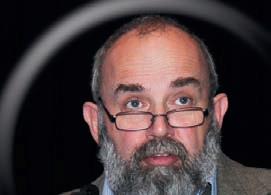




He also underlined, however, that for all this to happen we need a commercially viable shellfish industry that operates profitably and has access to the resources it needs.
Mike Spain, who recently took up his post as Director of Aquaculture and Marine Ecosystem Services at Crown Estate Scotland (CES) after several years as Head of Enterprise at the Scottish Association for Marine Sciences, explained the role played by CES. CES is not a regulator or a planning body, but as Spain put it, it is a self-financing public corporation created “to maintain and enhance asset values and income arising from the Crown Estate” with an additional mission to contribute to economic development, regeneration and social and environmental wellbeing in Scotland. In practical terms, this makes









CES the landlord for Scotland’s coastal waters and the owner of around half the Scottish foreshore. It is an asset manager, an investor and an enabler, and contributes more than £100m annually to the Scottish Consolidated Fund. It also supports local initiatives through the Sustainable Communities Fund. CES has granted 577 leases, of which 288 are to shellfish farms. Spain said: “The Scottish Government has ambitions for the shellfish industry to grow.”
An international view
Chile is renowned as one of the world’s leading producers of Atlantic salmon, but it is also home to a shellfish industry. Félix Howard-Brown was General Manager for St Andrews Mussels between 1987 and 2021, and he continues to be a consultant to the company. He shared his perspective as a Chilean shellfish farmer.





St Andrews operates its farms on Chiloe, the island where the Chilean mussel aquaculture sector is based. The company started by producing the Chilean fresh oyster (Ostrea chilensis) and then switched to Pacific oysters (Magallana gigas), finally focusing on blue mussels when a





virus affected the oyster population.


top: The ASSG Conference; Nick Lake; Mike Spain; Félix Howard-Brown
This page from top: Judges at t e o s ell s Awards 2024: (L-R)
Eleanor Adamson, Linda Wood, Nicki Holmyard, Michael Leathley and David Jarrad; Marie-Anne Omnes; the conference
ra e raised nds or t e oyal a onal
i e oat ns t on (RNLI). Pictured ( ) Mar o , ly Cerexhe and Cameron
o o t e it
Nick Lake

By 2021, production had reached 50,000 tonnes annually. All of the company’s mussel production is processed at its own two processing facilities and exported worldwide as IQF (individually quick frozen) meat, whole shell and frozen half shell. There is so far very little domestic appetite for mussels in Chile.
As Howard-Brown explained, there are more than 1,200 shellfish farmers in Chile, but only 3% of them harvest more than 5,000 tonnes. The vast majority (77%) harvest less than 1,000 tonnes and are typically small family firms. There is also very little scope for expansion other than through buying an existing licensed farm site.
For St Andrews, each platform can seed up to 4,800 10-metre ropes per day and the company can harvest up to 140 tonnes each day.
Although shellfish farming presents a successful export story for Chile, HowardBrown said: “There is no recognition from government, only difficulties.”
For Seafood Scotland, Marie-Anne Omnes gave an overview of the shellfish industry in France. The country is a net importer of seafood, she said, and in a recent survey just over six in 10 French consumers said they eat seafood at least once a week.
The aquaculture industry needs to be innovative and we believe shellfish has a big part to play

France is Europe’s third largest producer of mussels and ranks fifth worldwide, and the country is Europe’s leading producer of oysters.
As part of her research, Omnes attended the shellfish conference Recontres Nationales de la Conchyliculture in Vannes, Brittany. There are a number of issues for the industry, as Omnes described:
• There is a need to expand beyond the customer base – typical consumers are over 50s and affluent;
• Sales fluctuate with the seasons;
• Product education is needed;
• There is persistent inflation;
• Warming seas mean the shellfish are increasingly at risk from bacterial infections;
• Population density and water quality issues – water quality is the industry’s top concern;
• Recruitment difficulties;
• High cost of “labels” certifying origin; and
• The “French paradox” of local supply vs constraining rules.
The overall message is that the Scottish shellfish industry may be smaller, but it shares its challenges with producers in France – and the Scottish industry is dynamic enough to find a response.
Sarah Evans, Aquaculture Policy Officer with the Marine Conservation Society (MCS), gave a talk on “The future of shellfish – an environmental NGO perspective”, looking at the opportunities and challenges for the industry.
She said: “The aquaculture industry needs to be innovative and we believe shellfish has a big part to play in that.”


Spatial planning will be key, Evans argued, pointing out that Scottish seas are already busy with competing commercial users – such as fisheries and offshore energy – and there is a pressing need to “make space for nature”.
Integrated multi-trophic aquaculture (IMTA), combining different species such as finfish, shellfish and/or seaweed, presents some opportunities but there is still a question over whether this would be profitable, she said.
Another potential approach, she added, is co-location of finfish or shellfish farms with offshore wind farms. A pilot project is already underway in Denmark, with the Kriegers Flak Wind Farm, which is co-located with a mussel and seaweed farming operation. The project will be evaluated when it finishes in 2026.
Shellfish farming is not just “low impact”, Evans stressed, but “positive impact” and the MCS is promoting sustainable farmed shellfish as a responsible choice.
Also on the first day, shellfish expert and journalist Nicki Holmyard gave a presentation on the place of cultivated shellfish in the seafood marketplace (see her column, page 28, for details).
Harmful algal blooms (HABs) pose a threat not only to marine life but also to human health. Potential hazards include amnesic (ASP), paralytic (PSP) and diarrhoetic (DSP) shellfish toxins.
Clearly, a rapid, affordable and accurate test that can be carried out in situ would be a massive benefit to farmers. Currently there is no such test available, or at least not one that has been officially accepted. A previously available test, from biotech business Neogen, is no longer in production.
At the conference in Oban, attendees heard about two potential routes to solving
the problem: a project being developed by Robert Gordon University and the University of Aberdeen to develop a new lateral flow test for toxins, and a rapid test kit from Chilean company AquaBC.
For the former project, CyanoSol research group (RGU), co-directed by Professors Linda Lawton and Christine Edwards and project partners Scottish Biologics Facility (SBF, University of Aberdeen) and Lateral DX Ltd, are dedicated to developing new field tests using recombinant antibody technology for simple, individual, yes/no tests.
Christine Edwards, of Robert Gordon University, gave an update on this project, which has been making good progress. The University of Aberdeen has been developing “designer antibodies” for use as the basis of a lateral flow test, and evaluation of the tests is now underway, to see how well they detect a range of toxins. This has gone well so far, she said, and the tests are now being modified for further testing and production.
2022 concluded there is scope for “more, but different”. Following that, three workstreams were set up to explore three aspects:
• Can we make the ingredients?;
• Technical analysis; and
• What are the implications for the environment?
One of the big challenges regarding the first issue was deshelling – manual deshelling is not economically feasible, but cooking/ steaming (for cooked mussels) or high pressure processing (for raw protein) were found to be viable.



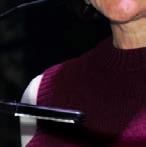



The good news was that it is feasible to create a mussel-based protein product without losing key nutrients, and the process does not involve any worrying environmental implications. Mussel-based protein tastes good, and would compare favourably, price-wise, to competitor products.




Also at the conference, Dr Andrew Turner, Principal Chemist and Natural Aquatic Toxins Topic Leader in the CEFAS (the Centre for Environment, Fisheries, and Aquaculture Science) Food Safety Group, gave an update on the evaluation of the AquaBC test.


He said that initially a lot of refinements had been necessary, with a large number of false negatives and false positives thrown up by the rapid test, when correlated with lab tests (which are more accurate but take much longer).
Dr Turner was optimistic that further changes will make the AquaBC tests more accurate. While the long-term goal is to develop the UK lateral flow test, an improved version of the test from AquaBC could present a solution at least for the time being.
Attendees at the conference were also invited to a practical demonstration of the AquaBC test and how to operate it.
Starting the second day, Aoife Martin, Director of Operations at Seafish, presented the findings of a Seafish study aimed at finding additional uses for mussels as a food ingredient. She stressed that this was not about replacing the classic role of mussels in dishes like moules mariniere and paella –instead it was about finding additional uses
The UK has the capacity to double mussel production, but to make that commercially viable will depend on opening up new markets.
The working group tasked to look at this in

Next steps will include a more detailed economic analysis and an examination of supply chain issues, but it looks as if the “mussel burger” could be on British menus in the foreseeable future.

Also at the conference, Tom Ashton gave a presentation on Native Aqua, a new name in Scotland’s shellfish sector, but one dedicated to reviving a traditional species, the native oyster (Ostrea edulis).
A former research scientist with breeding and genetics company Xelect, Ashton now farms native oysters at the Lochnell Oysters farm on the west coast of Scotland. As he explained, native oysters present particular challenges for aquaculture, as a “wild type”,






What we have to say and how we say it is vital ”
essentially an undomesticated species. Native oysters grow more slowly than the more commonly farmed Pacific oysters (Magallana gigas) and they can suffer high mortality.
Ashton is farming his oysters in an exposed location, in OysterGro cages away from the shore and, he said, this has delivered excellent results in terms of growth, survival and quality.
As he explained: “It’s not a cheap way of doing it, but in the cages the oysters tumble every day and this toughens them up.”


The 2023 seeds are now harvest ready as small “cocktail oysters”. The success of the project can be measured by the fact that Native Aqua won a special prize in the Scottish Shellfish Awards (see panel on this page).
Opposite from top: Oban; oi e Mar n elly
Wright; St Andrews m ssel la orm
Above: at ell s am ai n


The ASSG Conference was sponsored by Crown Estate Scotland, with additional financial support from Seafish, The Fishmongers’ Company and Seafood Scotland.

Attendees also heard from Konstancja Wozniacka, a researcher at Seafish, who presented results of a study evaluating the benefits shellfish offer for the environment, particularly in terms of improving water quality and removing nutrients that can lead to eutrophication and harmful algae.
Based on an analysis of the cost of water treatment, she said, even a conservative estimate suggests that the shellfish industry brings water quality benefits worth £7m.
Kelly Wright, who was appointed at the start of this year as Scottish Farmed Shellfish Ambassador, talked about her first 10 months in post . The role was created, with support from Crown Estate Scotland, in order to help market the industry.
Wright has developed an overall brand “Eat Scottish Shellfish” and two sub-brands for mussels and oysters. The focus this year has been on mussels and, coinciding with the conference, a website www. eatscottishmussels.co.uk has been launched, to give consumers information and recipes to help them try Scottish mussels.
The marketing campaign is based on research into why people buy mussels – and why they don’t, with “I don’t like them”, “I’m not sure how to prepare them” and “I don’t know how to cook them” as the top reasons for the latter. The campaign will also use social media and has already involved celebrity chef Tom Kerridge.
Wright said: “What we have to say and how we say it is vital. Get involved and help us to build our message!”
The conference also saw presentations from James Fennell of the University of Stirling, on the mussel shell weakness; Graham Brown of JFC Marine on buoys and moorings; Graham Fielder of Fielder Marine Services on screw anchors for marine farms, and from Gary Harty on the Hexcyl and Flipfarm farming systems.
See Fish Farmer’s video report: https://youtu.be/sPkZhK4JbFo
The next annual conference will take place, in Oban once again, on 1-2 October 2025.
THE Scottish Shellfish Awards, held as part of the conference, recognised the best in farmed oyster and mussel production, including a new category for “cocktail oysters”.
The winners were selected by an expert panel of judges.
In the Native Oyster category, the winner was Craig Archibald of Islay Oysters, with Gerard Macdonald, Isle of Barra Oysters, being highly commended.
The winner in the Gigas (rock oyster, or Pacific oyster) category was Swein Thomson of Orkney Oysters. Andy Abrahams of Colonsay Oysters was highly commended.
In the Mussels category, the winner was Douglas Wilson of Inverlussa Shellfish and Loch Fyne’s Hebridean Mussels (part of the Associated Seafoods group) were highly commended.
This year, the judges also opted to make an extra award to Tom Ashton of Native Aqua for his “cocktail oysters”, small native oysters grown offshore using an innovative approach.
The judging panel was chaired by journalist and shellfish grower Nicki Holmyard and also included: Eleanor Adamson of the Fishmongers’ Company; Linda Wood, Aquaculture and Fisheries Manager, Marks & Spencer; Michael Leathley, Head Chef at the Pierhouse Hotel, Appin, and David Jarrad, Chief Executive of the Shellfish Association of Great Britain.


The latest wave of land-based farming projects represents an exciting new era for aquaculture, but is the ambition matched by practicality? Fish Farmer’s expert panel considered the question in our latest webinar












THUE HOLM is Managing Partner at Aquafounders Capital and a director of The Black Cod Company.
more standardised, cheaper way of building land-based systems, and we also felt it needs to be much easier to operate these systems.”
At Swansea University, the Centre for Sustainable Aquatic Research operates 15 separate RAS systems in 13 labs, housing fish at temperatures of 8°C to 30°C and from full salinity to freshwater and anywhere in between.
Paul Howes explained: “We have three core missions: to enhance the student experience; to produce impactful papers; and to work with industry to answer industry related research and innovation questions.
“So my role is to be somewhere between academia and industry, to form a bridge between those often disparate areas.”
PAUL HOWES is Manager at the Centre for Sustainable Aquatic Research, University of Swansea.
Salmon Evolution has a salmon farm at Indre Harøy on the Norwegian coast. It is a hybrid flow-through system, which as Trond Schaug-Pettersen explained, contains elements of both a RAS facility and a flow-through system.
He said: “We have tried to capture the benefits of both a full flow through system and a RAS system, where you have high recirculation.
“For us it’s all about three things, first providing a good environment so you can take the full growth potential of the salmon; secondly, reducing operational risk to a minimum; and finally, if something happens you need to be able to contain it.



TROND SCHAUGPETTERSEN is CEO of Norwegian land-based fish farming company Salmon Evolution.
The discussion was facilitated by ROBERT OUTRAM, EDITOR, FISH FARMER
AN impressive amount of investment is pouring into landbased fish farming around the world, from Scandinavia and the Middle East to Florida and Japan. But can the technology and biology combine to ensure this industry has a profitable future?
This was the question we set out to answer in the latest in Fish Farmer’s series of Aqua Agenda webinars.
Thue Holm has gained experience in the course of a long career in aquaculture, including a role in the creation of RAS salmon producer Atlantic Sapphire, and now as Managing Partner of Aquafounders Capital, which he started jointly with fellow entrepreneur Ohad Maiman, who had been CEO at The Kingfish Company, another landbased fish farming business.
As Holm explained: “We had both experienced, the hard way, a lot of the issues.”
Their current projects include The Black Cod Company, which plans to produce black cod in the Netherlands, and Farm In A Box, which has developed a modular RAS (recirculating aquaculture system) farm system designed to make farm set-up quick, easy and cheaper than the typical “bespoke” approach.
Regarding The Black Cod Company, he said: “We believe that locally produced, high value species can give a price point that a RAS farm needs. You can also deliver a fantastic story to the consumers.”
For Farm In A Box, meanwhile, he said: “We wanted to create a
“About one-third of the water in our system is a constant flow, and we recycle up to two-thirds.”
He added: “We have had very good biological results. When you are doing innovation at scale you always encounter challenges, but the big picture is that this has been working very well.
“In the first half of this year we became profitable for the first time, which was a huge milestone for the company, and we had farming margins on a par with some of the best conventional farmers.
“For us, it’s never been clearer that this is working.”
Scale has been the theme for many of the land-based projects underway around the world. So why does size matter?
Thue Holm said that scale is necessary to offset the capital costs of a RAS or flow-through farm. Also, he argued, the lack of an existing industry in many regions where these farms are being built – like Florida, or central Japan – means that issues like feed, processing or










distribution can be problematic at a small scale.
Paul Howes added: “When you scale, you have the ability to have a much longer viewpoint and weather the storms when prices change. If you’re somewhere in the middle, your profit margin can quickly move into debt.”
And Holm added: “That’s also why we went for black cod because it’s a niche market, and really high value. So you can either go for scale, in a commodity, or you can go small and target a niche market.”
Another question concerned production challenges. How serious is the risk of disease, or off-flavours like geosmin?
Biosecurity should be manageable in a RAS farm, Holm argued, which should mean minimal risk of diseases or parasites, although issues such as a potential build-up of hydrogen sulphide could cause problems if not carefully monitored.
Trond Schaug-Pettersen said: “Off-taste is not an issue for a hybrid flow-through system, but the more water you use the more challenging it is to ensure disinfection.
“You need to start with healthy smolt. In our system we filter out particles and we also disinfect the water with UV.
“There will always be a risk that something will get through. But if you have a healthy environment and healthy fish, normally that would not be a problem.”
“One of the main benefits of our system is that you don’t have to deal with sea lice, so there is less handling and you have a stronger fish.”
There are currently competing RAS systems, but will aquaculture technology be standardised?
Thue Holm argued: “For RAS farms there are a lot of technologies but the basis for a RAS farm is very similar – there will be particle removal, some type of biofilter, some type of degasser, disinfection and oxygen injection, and it has looked like that for 40 years.
“We see diversification in agriculture and it is the same with aquaculture.”
So how aware are consumers of the increasing share in the seafood market taken by land-based farms?
Paul Howes said: “A lot of consumers just want to look at what the price is. Budgets are tight and consumers want value for money, but they also want to know that, for example, the fish or shrimp was not grown in polluted waters or has been grown to high welfare standards.
“People in some countries are eating less fish so that’s a challenge. While in others, people have more spare cash and are looking to import seafood products.”
Trond Schaug- Pettersen pointed that this question also relates to scale. If the producer is selling fish as a commodity, the fact that there is not enough supply to guarantee its availability all year round is not a problem – but it is a problem if you are selling it as a unique brand.
He added: “Also, you need to communicate the story and this takes time.”
The panel also discussed what might constrain the growth of this
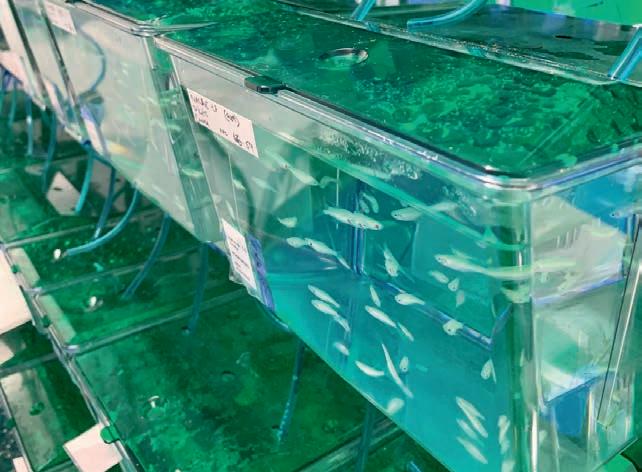





sector. Availability of capital is a key issue, but so is the availability of people with the required skills to run a fish farm system. The knowledge and experience of local regulators is also an important factor, so those countries with an existing aquaculture industry have a definite advantage in the development of land-based fish farming.
So, what will the industry look like in five years’ time?
Trond Schaug-Pettersen said: “Land-based will be a big part of the way we produce salmon, over the next five years probably not so much, but more companies are heading towards a base size and you will get an inflection point. So, in 25 years, it will be quite a big industry.”
Paul Howes said he expects to see several huge companies, maybe integrating RAS aquaculture and cage farming, but alongside that a proliferation of the smaller niche RAS systems around the world, tailoring their product to local markets.
Thue Holm agreed that land-based aquaculture has a bright future: “I’m very bullish on the sector”.
Scan the QR Code (right) to watch the whole webinar online at: https://youtu.be/ lNTW6D3MR90

For us, it’s never been clearer that this is working

, ni ersity o ansea

The next Aqua Agenda webinar, on TECHNOLOGY, REMOTE MONITORING AND ARTIFICIAL INTELLIGENCE, takes place on Wednesday 19 February 2025, 11.30am-12.30pm UK time. To register for this free event use the QR code above.



Warming waters off the far north of Norway have been linked to a big increase in sea lice numbers, as Vince McDonagh reports
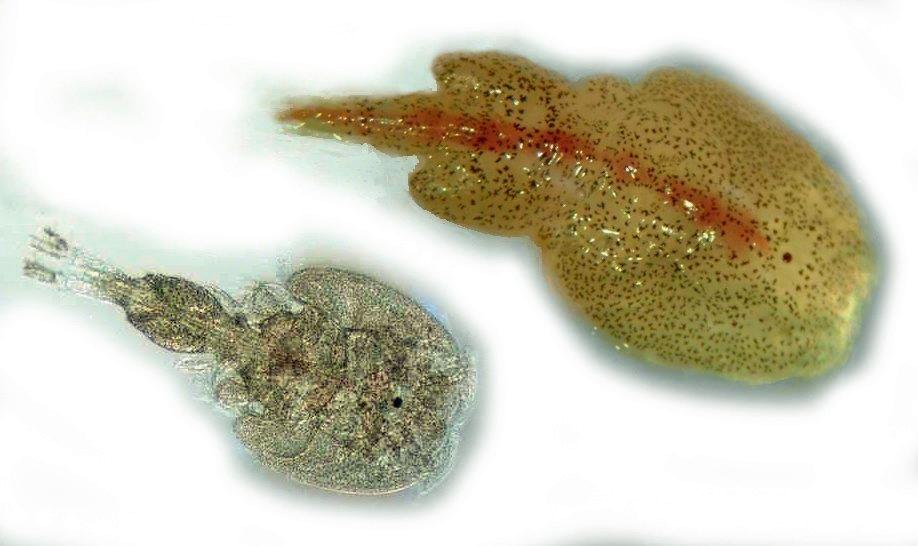
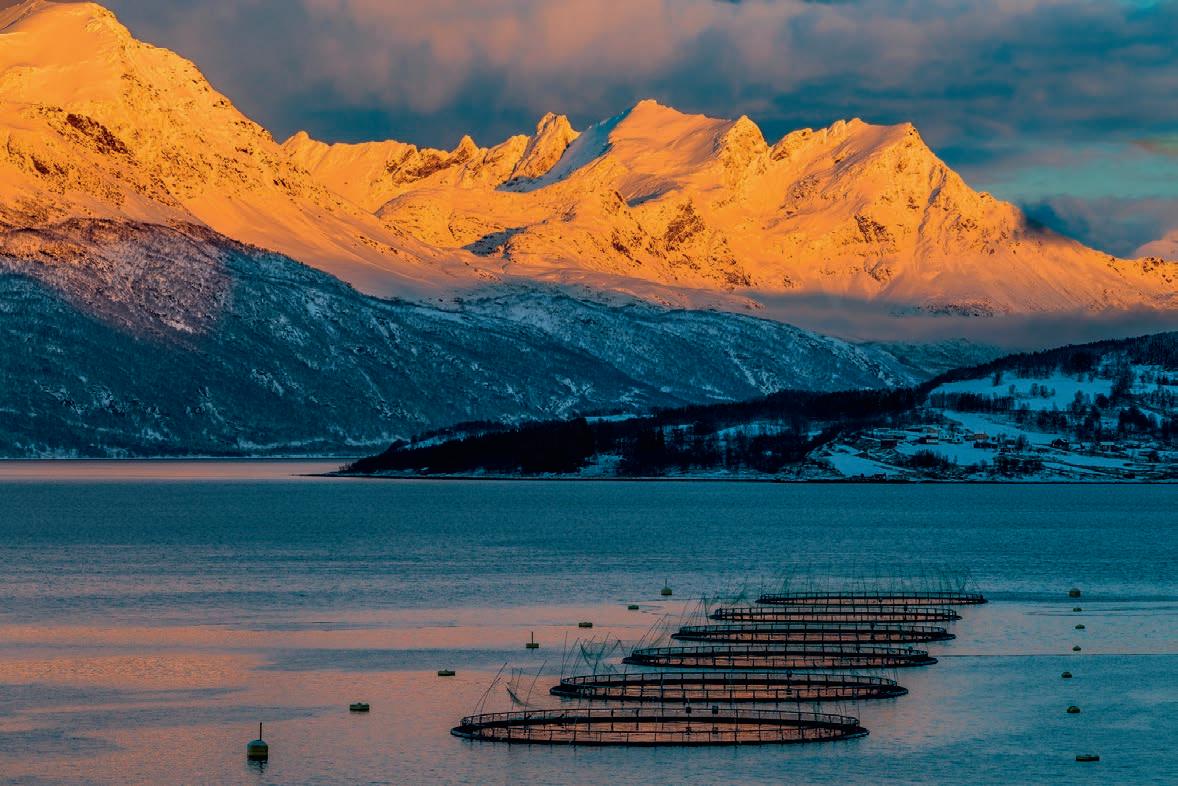
NORWAY’S salmon farmers have been shaken this autumn, not just by high lice numbers, but by just how far north the problem has spread.
Until now sea lice have not been an issue above the Arctic Circle, but the situation has changed.
Sea temperatures have been up to 5ºC above average, resulting in extraordinary high lice numbers, with several farms recording up to eight times the legal limit.
The Norwegian Institute of Marine Research says 16.85ºC has been measured at its station in Lofoten. Usually, local sea temperatures are around 12-13ºC at this time of year.
The lice limit is normally 0.5 adult female lice on average per fish in the facility. According to the figures from lice data, far more facilities are now well above that figure.
So far companies are receiving little sympathy from the government which is insisting on pain of financial penalty that the industry gets its
numbers down and keeps them down.
Fisheries and Oceans Minister Marianne Næss said bluntly that the industry must learn to live with this new problem, suggesting they get advice from southern fish farms which have been battling increased sea temperatures and high lice numbers for a while.
We are concerned that temperature changes are coming faster than we have predicted
It is an issue climate scientists have been warning about for some time and it is one which they say could become permanent.
Norway’s Institute of Marine Research, which keeps a close watch on development, has described the situation as “explosive”.
Marine Institute researcher Anne Sandvik, who collects data on a weekly basis, says lice numbers in the north have never been higher.
She uses the numbers to calculate how many salmon lice escape from farms and where they drift with the ocean currentsbefore they have grown into infectious lice that can settle on fish.
She told the institute’s news site there had been an explosive increase in the region and a doubling of numbers. Trout and char were also affected.
The timing of the increase means that sea trout may also have been exposed to lice attack.
“When the louse larvae have developed into infectious copepodites, they are ready to attach themselves to salmon, sea trout or char,” she explained.
“While the salmon swim out to sea in early summer, the trout spend a longer period of time in the fjords and become particularly vulnerable.
“The risk of sea trout becoming infected with harmful amounts of lice has also increased in recent weeks,” Sandvik added.
As an example, she points out that in midsummer, there were more than twice as many adult female lice on the farmed fish in one area (PO8) than at the same time a year ago.
In addition to the institute’s fixed stations, the researchers have access to the breeders’ temperature measurements via the information organisation Barentswatch.
Temperatures are taken at depths of three metres and this year the water temperature has been a great deal higher (up to 4ºC above normal) which gives the lice a huge advantage, she said.






limit from week 27 in the north), this cage
limit from week 27 in the north), this cage will have 50,000 to 100,000 adult female lice before there is a requirement to de-louse the fish.”
The institute’s scientists say the pace of the life cycle of salmon lice depends on the temperature. At high levels, it goes faster; that is, the lice become adults sooner and begin to reproduce. In addition, their ability to attach to a fish increases with increasing temperature. This in turn leads to more lice, both adults and young, at the same time. Sea temperatures, which are quite different from normal land weather trends, have been rising gradually for some time but this year they have been exceptionally high.

Scientists fear this is becoming the norm and water temperatures will continue to rise setting new challenges for salmon companies, and not just involving lice.


This is broadly the same as the seas around western Norway which are generally much warmer than around the Arctic Circle.
One northern farm produced millions of larvae. And although lice are found naturally in the sea, most are now found on salmon farms. And this year, an unwanted production record is being set in the north.

Strangely, in the south, the water temperature has been fairly normal during the summer when it might have been expected to be correspondingly higher.
Although the total number of adult female lice has gone up in the north, again it has not happened further south.


Sandvik explained: “If we start from the fact that a single cage contains between 100,000 and 200,000 fish, and each of these has 0.5 adult female lice (which is the legal
High lice numbers may be here to stay
The industry is worried that this year’s development is not a “one-off” and could lead to production problems.
Seafood Norway CEO Geir Ove Ystmark said the aquaculture industry uses wellboats and service vessels to carry out lice removal and warns that when so many companies need de-lousing at the


same time, it creates capacity challenges in northern Norway.
“We are concerned that temperature changes are coming faster than we have predicted. It is generally cause for concern, also for the aquaculture industry, which is now experiencing higher lice pressure,” he said.
As a consequence of the fact that northern Norway generally has lower sea temperatures, sufficient capacity has not been built up to handle the lice pressure now being experienced.
“The situation we are now experiencing, we must prepare ourselves for what could become a new normal,” he added.
The requirements to maintain a very low incidence of salmon lice in farming have been set to limit possible spread to wild salmon.
Lice are one of the biggest challenges facing the aquaculture industry. The strategy against salmon lice is to combine preventive measures with the use of treatments to remove lice from the fish.
The treatment methods are either the use of drugs or the use of so-called non-drug treatments. The latter is, for example, bathing in fresh water, rinsing and using slightly heated water (so-called thermal treatment).
The use of medicinal treatments is selflimiting due to the possible development of resistance in the salmon lice. When resistance develops, one consequently becomes more dependent on nonmedicinal treatments.
Most treatment methods (including the use of some drugs) require that the fish must be handled to a greater or lesser extent, and that in itself is a challenge for safeguarding fish welfare, as it leads to increased vulnerability to bacterial and viral infections.
The Scottish Parliament’s Rural Affairs and Islands (RAI) Committee has almost completed its series of hearings for its inquiry into the Scottish salmon industry, following up its earlier report (2018) to the Scottish Parliament recommending reforms. What have we learned and how soon can we expect the committee’s findings? Sandy Neil reports
ONE word kept recurring in the Holyrood inquiry into Scotland’s salmon farming industry, following up on progress since the last one in 2018: “disappointing”, even bordering on “depressing” for the MSP who led it.

Islands Committee (RAIC), launched a follow-up inquiry to ask whether recommendations from the 2018 inquiry had been implemented.


Back in November 2018, MSPs on the then Rural Economy & Connectivity Committee (RECC) said urgent action needed to be taken to improve the regulation of the industry and to address fish health, and environmental challenges.
At the time, the RECC set out 65 recommendations about how problems, such as the control of sea lice, rising fish mortalities, and the need to reduce the sector’s impact on the environment, should be tackled.
Earlier this year the RECC’s successor at the Scottish Parliament, the Rural Affairs and
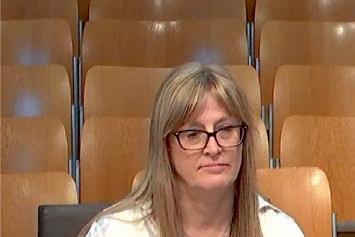
Evidence sessions began in June, and the last one, hearing from the Cabinet Secretary for Rural Affairs, Land Reform and Islands, Mairi Gougeon, is due on Wednesday 13 November, and the committee’s final report is expected by the end of the year.
You can read our many reports at www. fishfarmermagazine.com, from 5 June when MSPs heard the case against salmon farming, 12 June when the Fish Health Inspectorate spoke of “improving” sea lice control, as well as a controversial fact-finding trip on 23 September and the denial of a “cover-up” of dead fish on 2 October. But in the magazine this month, we focus on the progress (or lack of) revealed in the three hearings, about
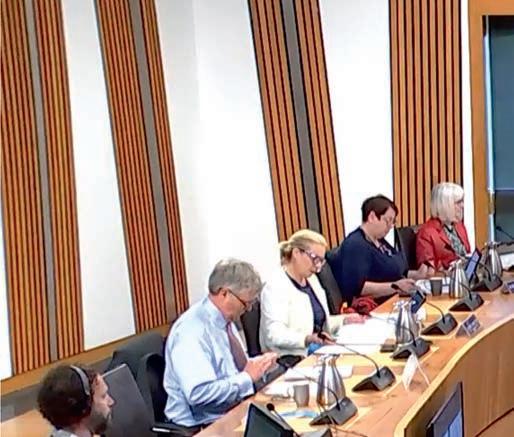

research and regulation on 19 June, declining wild salmon on 26 June, and planning changes on 18 September.
For a neat summation of everything said so far though, we can turn to 26 June, when the RAIC’s Convener, Finlay Carson MSP (Galloway and West Dumfries, Conservative), asked John Goodlad, Chair of the Salmon Interactions Working Group: “What is your broad assessment of progress on implementing the recommendations of the reports of the RECC and the Salmon Interactions Working Group?”
Goodlad replied: “Our group came up with around 40 recommendations and, as far as I am aware, the only one that has really been acted on is the one about the sea lice framework. We spent a lot of time and effort producing a lot of recommendations, so it is disappointing that so little progress has been made.”






Carson also asked Dr Alan Wells, Chief Executive of Fisheries Management Scotland, the same question. Dr Wells agreed: “It is disappointing there has been so little progress on those two reports.
“It was an excellent example of collaboration between the wild and farmed sectors. We got the right people round the table, with a shared determination to come up with recommendations that were designed to improve the situation.
“I am strongly of the view that, once delivered, those recommendations would greatly improve the situation. Unfortunately, despite an initially positive response to the report, the Scottish Government has not taken the opportunity to act on the majority of those

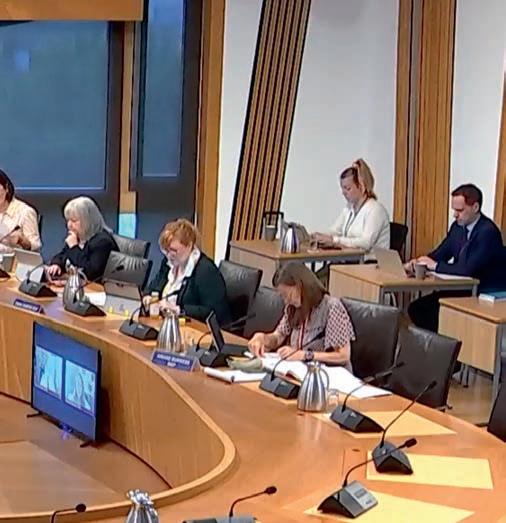

recommendations, which is pretty disappointing.”

lack of co-ordination.




It was then the turn of the RECC’s former convener, Edward Mountain MSP (Highlands and Islands, Conservative), to ask Goodlad: “I have read your report, which I think was published in May 2020. You will be as proud of it as I am of the RECC’s report, which had 65 recommendations. Do you think that I am right to be disappointed that few of those recommendations have been implemented?”


Goodlad replied: “As someone who chaired a committee that produced a report whose recommendations have largely not been implemented, I am disappointed, so I imagine that you are absolutely right to be disappointed, too.” Disappointment may, therefore, feature in the final report.
Overall MSPs asked a great number of questions, and speakers answered in great detail, enough to fill an entire magazine issue, so in this month’s report we shall focus on any progress revealed in three hearings, starting on 19 June. At this session, the RAIC discussed a report by the Scottish Science Advisory Council (SSAC), titled Use of Science and Evidence in Aquaculture Consenting and the Sustainable Development of Scottish Aquaculture, published last year.






“On who should pay for the research, it is not unreasonable to say that the industry itself should pay, as happens in Norway, through various mechanisms such as levies. The industry contributes, but perhaps there is something to be said for looking at that further.”















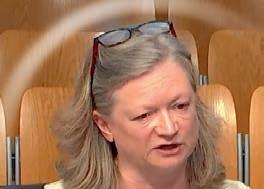


The RAIC Convener, Finlay Carson MSP, began: “One of the RECC’s recommendations was to identify significant gaps in knowledge, data analysis and monitoring, but your report also identified a gap in funding for policy-driven research on aquaculture. Do you think that there remains that gap in funding but also a lack of co-ordination on research and the funding that ties it together?”
The SSAC’s Professor Nick Owens, said: “Yes - most certainly. Given the value of the industry to Scotland and the Scottish economy, our understanding and belief are that there really should be more funding available. The whole issue of getting scientific advice, using it properly and getting it communicated properly is very much influenced by the
Another challenge was raised by Beatrice Wishart MSP (LD, Shetland Islands), who asked Prof Owens: “The Griggs review identified ‘mistrust, dislike, and vitriol ... between the industry ... regulators, parts of the Scottish Government and other stakeholders’. Your review found that ‘science on aquaculture ... is not sufficiently visible’ and that there was ‘a lack of shared arenas for voicing concerns and dialogue which continues to fuel a perception of secrecy and misunderstandings’. Will you expand a wee bit on the challenges that your review identified?”
Professor Owens replied: “There is no doubt that lack of trust is still there. I suspect
It is disappointing there has been so little progress
that, whatever one could do, there will always be an element of that, because people will take, and have taken, entrenched views. The view out there is incredibly binary.
“Research is being done on how to communicate and engage effectively with communities that hold differing views. Using the mechanisms that exist, there is definitely a route by which we can at least try to make an improvement in bringing the two communities together.”
It was then the regulator’s turn in the hot seat. Lin Bunten, Chief Operating Officer for Regulation, Business and Environment at the Scottish Environment Protection Agency (SEPA), spoke of “significant progress”.
“We were in complete agreement that the status quo was not an option,” she said. “The committee’s subsequent report highlighted 65 recommendations, 22 of which involved SEPA in their implementation.
“Since 2019, all new and expanded farms have been regulated under the enhanced framework and, by the end of this year, we plan to have completed the rollout of the same standards to all remaining operational farms.
emamectin benzoate in the same quantities as in 2018?”
Montague replied: “It is fair to say that the bulk of the operational farms are still on the standard from 2018. Since the UK technical advisory group process identified a new standard, it has been applied to new and changing sites, but we await Scottish Government direction on implementing it for existing sites.”

Burgess, expressing surprise use had not reduced, concluded:





“Urgent action was called for in 2019, I think, and we are now quite a long way off from that.”
Emma Roddick (Highlands and Islands, SNP) then asked: “What is SEPA doing to improve data transparency?”
“The regulatory landscape has been simplified to provide greater clarity. That includes the transfer to SEPA, in 2020, of wellboat medicine discharge regulation and, in February this year, of responsibility for managing interactions between sea lice from fish farms and wild salmon.
“We are starting to see the impact of the changes. They are helping developers to identify the most suitable locations for new farms that better align to where there is environmental capacity to accommodate them. That is noticeable in the emerging trend of a smaller number of larger farms in more dispersive coastal areas.

Bunten replied: “The information is published on the Scotland’s Aquaculture website. That information has grown in volume and subject matter over the period since 2019.”
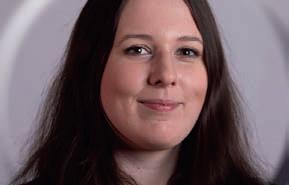
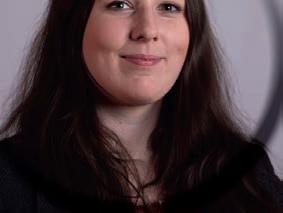
“In 2023, we inspected 120 sites, whereas this year we plan to inspect 112 sites. We are inspecting roughly 60% of operating sites annually, and every data return made by every farm operator from every site is checked for compliance. This year, we plan to undertake 22 sea bed surveys.
“Completing the roll-out of the framework is a really big step and means that, as farms undertake the enhanced monitoring over the next two to three years, we will have a fuller understanding of the impact of those farms.”
Ariane Burgess MSP (Highlands and Islands, Scottish Greens) then asked: “How have the regulatory changes that have been made since the RECC’s report impacted on chemical use and waste arising from fish farms?”
Aquaculture specialist Mike Montague replied: “Over the past 10 years, we have seen a decline in the amount of medicines that are used on farms, and that has probably stabilised a bit over the past five years. Our remit is to use the environmental standards to set limits on a site-by-site basis. We set limits and, if the operator stays within those limits, the impact on the environment is at a scale that is deemed acceptable.”
Burgess asked: “So, you are saying that the 210 farms will have different limits on the medicines that they can use, depending on circumstances such as their location. How many farms are still using

Montague elaborated: “We now publish information on all medicine use, biomass compliance and the outcomes of the sea bed surveys.”
The former RECC convener, Edward Mountain MSP, asked: “Recommendation 51 of our ‘Salmon farming in Scotland’ report asked for priority to be given to creating ‘a spatial planning exercise’ to see where salmon farms could and could not go. Do you have a map of the waters around Scotland showing where it is suitable to have aquaculture and where it is not? That is what the recommendation called for.”
Bunten replied: “The answer is no.”
Mountain commented: “And that is five years later. Recommendation 10 of the RECC Committee’s report is that ‘there should be a process in place which allows robust intervention by regulators when serious fish mortality events occur’. Last year, mortality at Kishorn farms A, B and C over three months varied from roughly 37 to 43 to 48%. That is nearly 50% of the fish in one of those farms dying in a three-month period. Did you inspect them? What was the outcome of that inspection?”
Montague replied: “Mortality is not within our regulated remit. Effectively, we do not have a role in that place.”
Mountain said: “So, you have no role in worrying about mortality and the effect that that will have on the environment?
Bunten answered: “The dead fish are removed from the environment. Our role is very much about protecting the water environment.”
Mountain asked: “Do you have any idea why those deaths happened? If it was to do with
The regulatory landscape has been simplified to provide greater clarity ”
gill health, the transmitter of poor gill health would have had an effect on the rest of the environment, would it not?”
Bunten replied: “There is another body that has responsibility in that area.”
Mountain commented: “That probably demonstrates the fact that it is unclear who should be doing what.”
The next RAIC hearing on 26 June focussed on the interactions between wild and farmed salmon. The Convener Finlay Carson asked John Goodlad of the Salmon Interactions Working Group: “This topic can be very polarising. There needs to be a balance between commercial interests and the huge importance of the wild salmon population.
“In your report, you say that ‘developing a professional and collaborative working relationship’ in that is really important. That does not appear to be working at the moment. Have you any ideas about how the arguments could become less polarised?”
Goodlad replied: “We absolutely have to have greater discussion and try to find common ground. Salmon farming is an incredibly important industry and has a bright and prosperous future. Wild salmon stocks are in a dreadful state; they are now on the endangered species list. However, the simple conclusion that one is causing the other is not the case.
“The wild fish sector has two main concerns - which are legitimate - about fish farming. The first is sea lice. As smolts swim past fish farms, they may become infected with sea lice. Secondly, there is the risk of escapes and genetic introgression. It has been put to me that, given that wild salmon stocks are at such a low and, indeed, endangered level, genetic introgression is probably a worse potential problem than ever. However, on the other hand, escapes are probably at as low a level now as they have been for many years.
“The honest answer is that no one really knows why wild salmon have declined so drastically. Twelve reasons have been put forward, and we referred to those in our report. Clearly, fish farming is one that gets a lot of attention - rightly - but there are, perhaps, 11 other reasons. Much work needs to be done on all those areas.



million tonnes of western mackerel historically is now around four million tonnes.
“Secondly, the stock has moved northwards. The mackerel fishery used to be off Cornwall and the Western Isles, but now Shetland is the southern part of the main fishery, with the fishery itself mostly around the Faroe Islands and Iceland. Mackerel eat exactly the same things that salmon eat - capelin and crustaceans - while large mackerel also eat small salmon. How many smolts does four million tonnes of mackerel biomass eat in a year?
“In my view, that is probably the main reason for the decline in salmon, but it is out of sight and out of mind and very difficult to ascertain, whereas fish farming is very obvious and very much in people’s sight.
“There is a huge sense of disappointment on the part of the interactions working group that there was this focus on the interaction between wild salmon and fish farming.”



“If I was asked to place my bets on the main factor leading to wild salmon decline, I would say that it is happening in the north Atlantic. The salmon smolts go to sea and feed in the waters between the Faroe Islands, Iceland and Greenland; however, something is happening out there.
“Climate change has resulted in two things happening with the western mackerel stock. First, the western mackerel stock biomass is now at record levels. What had been 2.5
At the next hearing on 18 September, Ariane Burgess MSP focused on the RECC’s recommendation from 2018 noting “too high” mortalities across the sector and calling for no expansion of sites which report high or significantly increased levels, unless cleared by regulators.
Since then, Burgess said, salmon deaths have risen higher. “Throughout these evidence sessions, we have heard about high mortality,” she said. “One example is of a salmon farm in Loch Seaforth in the Western Isles, where more than a million fish died in a production cycle in 2023, and the level of suffering carried on for six months without any consequences.
“Already high levels of mortality are increasing - possibly due to climate change but maybe for other reasons - but nobody in the process seems to be responsible for the mortalities. We cannot quite get to the

bottom of it. Do you have any thoughts on that and on what we can do about it?”
Mark Harvey, Planning Team Leader, Highland Council, replied: “Undoubtedly, environmental factors are emerging, or have emerged recently, in relation to gill disease on fish. In fact, that issue has probably overtaken by a long measure the health effects of sea lice. However, it would be difficult for planning to take that into account.”
The former RECC convener Edward Mountain MSP asked: “I take you to recommendation 53, on the relocation of fish farms where it is clear that they are a problem. How many planning applications has Highland Council received, considered and actioned for the relocation of fish farms because they are a problem at their existing site?”
Harvey replied: “I do not think that we have reached the first stage yet, because we have not identified where there are problematic fish farms. That is another aspect of the framework that might be particularly useful, because SEPA might well be able to identify such farms, in which case we would certainly take a view on relocation.
“How different an application for relocation is from an application for a new fish farm is another matter. We do not control whether a company wants to close down an existing fish farm, although that might be what SEPA requires. We would obviously look at a fresh fish farm application in much the same way as we would any other application.”
Mountain commented: “Do you know how depressing that is for me? I sat on the predecessor committee in 2018 when it recommended that poorly sited fish farms should be relocated to take away the threat in relation to their production from high mortality levels and their effect on wild fish where the farms are sited on existing migratory routes, and now you are telling me that, six years later, that has not been implemented.
“I will leave it there, Convener, because I may get more depressed as my questioning continues.”
Can an emergent seaweed industry be the disruptor that triggers blue growth across a number of priority sectors for Wales? A recent report suggests that it can, if the right action is taken

AS things stand today, Wales has only one seaweed farming business, one licensed farm not yet operating and one small hatchery on Anglesey.
That could all change, however, according to a study that has highlighted what seaweed could mean for the Welsh economy. Project Madoc is a comprehensive 12-month feasibility study, funded by the European Maritime and Fisheries Fund (EMFF). Its purpose was to assess the economic viability, environmental impact and social acceptability of developing a sustainable and competitive industry for Wales, based on the cultivation and downstream processing of selected species of native seaweed.
Project Madoc’s intro states: “Wales now stands again on the brink of a new era of opportunity originating from and beyond our remarkably diverse coastline… this catalytic project illuminates an opportunity to accelerate a shift to a new and regenerative industry based on the sustainable farming of selected, native species of seaweed.”
And goes on “Seaweed is among the most scalable of nature-based solutions.
“Alongside its economic advantages, it can offer tangible solutions to the challenges posed by climate change and provide a plethora of ecosystem services.
“To do these things, however, it has to be farmed and at scale.”
Project Madoc (named after a legendary seafaring Welsh prince) was led, edited and managed by The Seaweed Alliance, a not-for-profit body, with input from selected independent experts.
The Seaweed Alliance co-founders Charles Blair and Fiona Trappe both came into the seaweed industry in 2017, from a background in regional development and regeneration.
As Trappe explained, their interest developed after seeing an example of seaweed cultivation in Tasmania (where Blair was living): “We were looking for untapped opportunities in the UK.”
The report warns that Wales is lagging behind countries that have done more to embrace this opportunity, including Norway, the Netherlands, Ireland, Australia and Scotland.
It says: “The highest ambition scenario indicates that Wales has the potential to build a £105m industry, contributing £76.3m to GVA (gross value added) and close to 1,000 jobs by 2033. This does not include the associated supply/value-chain or potential monetary value of ecosystem services derived from seaweed cultivation and resultant replacement of carbon intensive products. Viewed in the round, this equates to Wales generating £29.4m in salaries and remuneration, £81m revenue, with a profit of 27%”
Charles Blair said: “The desire is there, but what’s needed is investment. It’s not just about primary production, it’s how it feeds into life sciences, biotechnology and so on. We need to turbocharge seaweed to elevate it from the peripheral into the mainstream as a driver of socio-economic growth for the wider Welsh economy in the context of the Well-being of Future Generations (Wales) Act, 2015.”
As an integral part of diligence research, the authors commissioned a comparative analysis
specifically with Norway, The Netherlands and Japan as case studies.
Blair explained: “This went a lot deeper than relying on secondary sources. We wanted to know - and to convey to stakeholders - what Wales could learn from those cases and transfer and adapt for Wales to accelerate the establishment and growth of an industry in Wales; but much applies to the UK more broadly.”
The Netherlands has already started to explore the possibilities of seaweed farming, but, as Trappe and Blair are keen to point out, Wales has five times the coastline of the Netherlands and Belgium combined with a far wider range of coastal conditions and biodiversity. They pointedly question if we’re making optimum use of our natural (marine) capital. And, if not…why not? And how we change that?
Facilities and the technology for processing and biorefining will be key. Trappe and Blair stress that some investment by the state will be required to get the industry going, although it should not require subsidies indefinitely. Given this represents the emergence of an “infant industry” for Wales (as for most of the UK), some form of pumppriming intervention is not an outlandish proposition.
Native species with potential
The report recommends a focus on key native species - Palmaria palmata (dulse), Ulva lactuca (sea lettuce), Saccharina latissima (sugar kelp/kombu) or Alariaesculenta (winged kelp/Atlantic wakame). Specialising in this way would bring economies of scale benefits and accelerate innovation activities through simplification, the report says. The volume biomass that could be produced equates to 17,700 tonnes per annum by 2033. Project Madoc also recommends a phased







growth approach – a “beachhead strategy” – focussing resources initially on a small market area to create a stronghold for the future and enable seaweed farmers, industry processors, entrepreneurs, investors, and researchers to coalesce.

IntroductionandSummary

As well as biomass production, investment would also have to be directed to bioprocessing. All of which – across the entire seaweed industry supply/value-chain – presents Wales with opportunities for innovation, inward investment, technology and knowledge transfer resulting in quality, sustainable employment building resilience for coastal communities.



”The desire is there, but what’s needed is investment
Opposite from top: Fiona Trappe at NORTH SEA SEAWEED 2024, The Hague; SW industry graphic TSA “Model for a seaweed industry” This page from top: Welsh seaweed in 2040; Project Madoc front page; South Stack Lighthouse, Anglesey; sea le e d lse
The report says the findings of the environmental assessment conclude that, in the Welsh context, there would be minimal negative environmental impacts: “Overall, the potential environmental risks of seaweed farming would be outweighed by the benefits, including water quality improvements, enhanced biodiversity, bioremediation, and coastal protection.”
The key recommended next step is to develop a comprehensive Seaweed Industry Development Plan for Wales, in three phases:
• Promoting and supporting capacity-building and knowledge transfer, focusing on three native species – kelp, dulse and Ulva
• Creating industry demand to lead to scaling of farms and bioprocessing facilities to meet the needs of a seaweed bio-based sector.
• Co-location with offshore wind farms.
Madoc’s market analysis concludes that “agri-food” applications have the best potential to kick-start a seaweed industry in Wales (this includes food, food additives, biostimulants and feed) as there is already an established food and drink industry. This aligns with and lends voice to Welsh Government policy and strategies for what is predominantly a rural economy.
The report sets out a three-phase approach:
Phase 1: Initially deploy clusters of small-scale farms working as a cooperative, supplying the agri-food sector, ie, artisanal food producers and restaurants regionally. This will promote and support capacity building, knowledge and skill transfer as demand grows.
Phase 2: Increase scale of biomass production capacity by grouping into larger farms, sharing infrastructure, thus enabling economies of scale. Supplying mainstream food manufacturing and other highvolume applications such as feed and bio-stimulants for the agricultural and life sciences sectors. In parallel, consideration also needs to be given to harvesting seaweed from the wild to fulfil any shortfall in demand.
Phase 3: From 2030 onwards, extra-large scale, offshore seaweed farms, co-located with offshore wind farms, will begin to enter the water, thereby providing high volumes of relatively low-cost biomass for biorefining and opportunities within the “bio-based alternative markets” such as packaging, chemicals and biofuels.
The report acknowledges importance of support on the part of local communities (coastal especially, where the majority of the Welsh population live and includes Welsh-speaking areas), and the need to address environmental and other concerns. It points out that seaweed farms could be sited in areas with currently high levels of unemployment, providing opportunities for local jobs.
The report’s environmental assessment concludes that the environmental impact of seaweed farms could be mitigated by careful selection of farm sites, and points out that seaweed production also comes with a number of environmental benefits, such as improved oxygenation and de-acidification of water, and increased biodiversity. Farms could also help reduce coastal erosion by absorbing wave energy.
The report suggests that, in theory, almost 50% of the Welsh marine area is suitable for cultivating kelp. This equates to a total area of just over 1.5 million hectares – 106,000ha scored optimally – with a further 1,435,300ha considered suitable.
An analysis proposes five development sites for the first phase of






seaweed production: Llandudno, South Wales; Puffin Island, off Ynys Mon (Anglesey); Holyhead, Ynys Mon; Fishguard, southwest Wales; and Swansea, South Wales. In addition, Rhyl Flats Wind Farm could serve as a potential example for a co-location pilots.
The report argues: “The well-established ecosystem services offered by seaweed can form the basis of a sustainable, regenerative industry for Wales, with an array of high-value, commercial applications. It can feed the supply and value chains of a rapidly advancing Welsh bioeconomy, while at the same time replacing seaweed feedstock imported from East Asia…an evolving Welsh seaweed industry can form an intrinsic component of a wider new, blue economy for Wales, learning and adapting from excellent models in Europe and Australia to accelerate the agenda.”
And the authors conclude: “With the necessary levels of ambition, commitment and investment, a competitive Welsh seaweed industry is eminently technically and commercially feasible, and socially and environmentally desirable.”
Trappe and Blair acknowledge the diligent input by the report’s key contributors and for the many insights provided by a vast array of stakeholders and interviewees in the UK and internationally.
“But we have to now take this up the gears if Project Madoc is to prove impactful as a disruptor for blue growth,” they reflected.
The Seaweed Alliance stands ready to collaborate with interested parties in government, industry, academia and investors to lead that charge.


Our round-up of what’s new in fish
health focuses on new projects aimed at increasing the industry’s knowledge
THE Sustainable Aquaculture Innovation Centre (SAIC) has announced its support for three innovation projects aimed at enhancing finfish health and welfare in response to a changing climate and other emerging challenges.
The projects concerned will address three major biological threats to farmed fish: micro-jellyfish, harmful algal blooms (HABs) and proliferative kidney disease (PKD).
Valued at a combined £1.6m, these projects have secured nearly £600,000 in funding from SAIC along with additional support from businesses and organisations operating within the Scottish aquaculture sector.
Two of the successful projects are already underway. The first is exploring the development of a holographic imaging system to detect and monitor micro-jellyfish at aquaculture sites. It also aims to implement an automated profiling system for HABs in the water column, providing real-time data for fish health management.
The second project builds on previous SAIC-funded initiatives that established predictive biomarkers for assessing gill health in Atlantic salmon. Its objective is to refine these biomarkers using machine learning and non-invasive sampling methods, while investigating their effectiveness in predicting responses to microjellyfish exposure and different diets.
Meanwhile, a third project is set to begin in November, focused on stock management strategies for PKD outbreaks in Scotland. The initiative will monitor environmental conditions and immune responses in fish using advanced techniques, aiming to develop predictive models that enhance health management practices and improve vaccine efficacy in aquaculture.

The latest funding awards build on SAIC’s work to date, which has seen almost £11m of investment turned into sector-critical research with a combined value exceeding £71m. These projects have led to the creation of spin-out companies, new products and services, and innovative approaches to tackling sector-wide challenges.
Earlier this year, SAIC announced that it had secured further funding that will enable the innovation centre to build on its work from over the past decade, following the withdrawal of financial support from the Scottish Funding Council, its main source of funds.
SAIC has now sharpened its focus on promoting positive health and welfare outcomes for farmed fish through applied research and knowledge exchange, particularly in response to emerging environmental challenges.
Sarah Riddle, Director of Innovation and Engagement at SAIC, said: “Over the past 10 years, we have prioritised initiatives aimed at enhancing aquaculture’s environmental impact, fish health, and unlocking economic potential. In this current funding call, our sharper focus aligns us even more closely with the sector’s key priorities, fostering collaboration to tackle critical health, welfare, and survivability challenges in fish farming – and each of these projects aims to tackle these areas. Continued knowledge

This page from top: Salmon swimming; Socorex needle
This page from top: Freshwater treatments via wellboats could help to combat bacteria; Duncan Colquhoun; Norwegian Veterinary ns t te
exchange between the sector and academia will also be vital in maintaining Scotland’s position at the forefront of pioneering advancements across the global aquaculture supply chain.”
Linsey Dickson, Interim Executive Director of Research, Innovation and Business Engagement at the University of Stirling, added: “This funding represents a significant boost to the innovative research being conducted across Scotland’s aquaculture sector. By applying cuttingedge technologies and evidence-based practices, these projects are poised to address some of the sector’s most pressing challenges. Close collaboration between academia and the fish farming community is crucial to ensure that our findings translate into actionable solutions that support the future of sustainable seafood production.”
Gill health investigated
Norway has launched an initiative to discover more about the growing problem of complex gill disease in salmon.

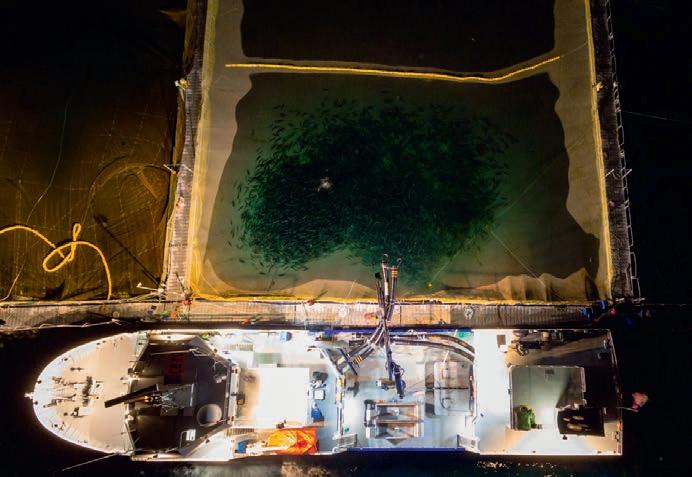


Fresh water ‘may be answer to salmon disease’
The bacterium that causes pasteurellosis in farmed salmon does not survive for long in fresh water, new tests have shown.

FHF, the country’s aquaculture and fisheries fund, has awarded NOK 15m (just over £1m) to look into preventive measures against the condition and to develop new tools to evaluate gill function at the edge of the cage.

Experimental work has been carried out by the Norwegian Veterinary Institute in this area which has thrown up some interesting results.

The institute said that the pathogenic bacterium Pasteurella has become more widespread in Norwegian fish farming in recent years and is also developing into a major problem for the industry.
Pasteurellosis has become an extremely serious disease, particularly in south-western Norway, and is now the third most important bacteriological issue for salmon farming, said the institute.

The FHF said that the challenges of complex gill disease have increased in recent years both in terms of frequency and geographical spread, but also in terms of complexity in causal relationships.
There are currently few tools available to tackle what FHF described as a complex problem.
FHF said the objective will be achieved through three separate sub-objectives, each of which must be answered in separate projects.
These are to evaluate the effectiveness of methods and strategies used in the industry against complex gill disease; establish and validate new methods that can be used at the cage edge to evaluate the respiratory capacity of the gills; and to test new measures that can reduce the risk of gill disease and the development of severe gill inflammation.
The aim of the call for tenders is to generate knowledge about preventive and mitigating measures against the disease and to develop better tools to assess gill function.
Our sharper focus aligns us even more closely with the sector’s key priorities
Now, a three-year project led by the Norwegian Veterinary Institute and financed by the Norwegian Food and Agriculture Organization (FHF) is providing more knowledge about the bacterium and how to combat it.
The report states: “Experiments with fresh water were carried out after an epidemiological investigation showed that the probability of an outbreak of pasteurellosis increases significantly after thermal or physical de-lousing with seawater, but not after freshwater-based de-lousing.
“In the laboratory experiment, it was investigated how long the bacterium Pasteurella atlanticus survives in water with different salt concentrations. But when exposed to 100% fresh water, the bacterium was inactivated within approximately one hour. “
Senior Researcher and Project Manager at the Veterinary Institute, Duncan Colquhoun, said: “Previous work has also shown that hidden infected fish secrete disease-causing bacteria during stressful handling.
“There is, therefore, reason to look more closely at whether



freshwater-based lice removal can reduce the severity and number of disease outbreaks after such treatments.”
A new environmental toxin has been found in farmed salmon in Norway, but for the moment the authorities are keeping an open mind on what action to take because the amounts are so small.
The substance is the anti-fouling agent tralopyril – also known commercially as ECONEA – which is being used to replace copper in the cages as a non-metal paint.


Bjørn Einar Grøsvik, a researcher with the Norwegian Institute of Marine Research (IMR), said: “The substance was found during laboratory tests and the amounts were only just above what could be measured.”

Nevertheless, he feels the discovery is worrying and should be taken seriously. The IMR is recommending that maximum residue levels (MRLs) need to be set for tralopyril, as they have already been for other agents.
“This is a substance that does not exist in nature in the first place, and there are also no set limit values for how much of it is acceptable in foodstuffs or ingredients used in animal feed,” Grøsvik added.
He compared tralopyril with other agents used by the farming industry, such as various drugs against salmon lice.
He said: “Such drugs can be found in small quantities in fillets, but limit values have been introduced for these substances where calculations have been made of how much is acceptable in terms of food safety.”
He explained there are large gaps in knowledge about tralopyril today, but in its risk assessment of the substance from 2023, the IMR refers to one study carried out on rats.
This showed that the levels of tralopyril found in salmon were significantly lower than the levels that had been found to have a negative health effect in rats.
Tralopyril can probably have a negative effect on the gills of the salmon, the IMR believes, explaining that farmed salmon probably ingest the substance when the fish that are exposed to it “bleed” the excess of the substance into the water.
This is shown by an experiment at the IMR, where the findings have not yet been scientifically published.
“If there is poor water replacement, in unfortunate circumstances one may find that the amount of tralopyril is concentrated to a level above lethal for fish inside a cage,” said Grøsvik.
Tralopyril inhibits the function and energy production of the
mitochondria in the cells, which prevents energy uptake and leads to oxidative stress.
This makes the researchers suspect that the substance may, at some levels, have a harmful effect on the fish’s gills.
“We have not been able to investigate this yet, but it may be close to believe that when the fish swim around in high concentrations, it will affect the gills negatively,” he added.
In the agricultural and veterinary fields, the quality and design of injection needles play a pivotal role in ensuring effective and ethical handling of animals. A good injection needle is one that not only serves its intended function with precision but also minimises discomfort for the animal and reduces the risk of injury to both the animal and the handler.
In a recent blog, Swiss precision dosing specialist Socorex spelled out the key factors when looking for the right needle for an agriculture or aquaculture application.
The company advises:
• Opt for high-quality stainless-steel needles (stainless steel specification 304 or 316) due to their durability, corrosion resistance, and sharpness.
• Choose appropriate length, diameter, and bevel design based on injection type, animal size, and skin type for effective and comfortable injections
• Ensure needles are securely packaged to prevent contamination. Packaging should be easy to handle for quick and efficient use.
• Handle needles carefully to avoid breakage, bending, and infection. Adhering to manufacturer recommendations and undergoing regular training are essential for user safety and animal welfare.
Tralopyril can probably have a negative effect on the gills of the salmon
This page from top: o s salmon en B rn inar r s i ( oto M ) reen al ae ells
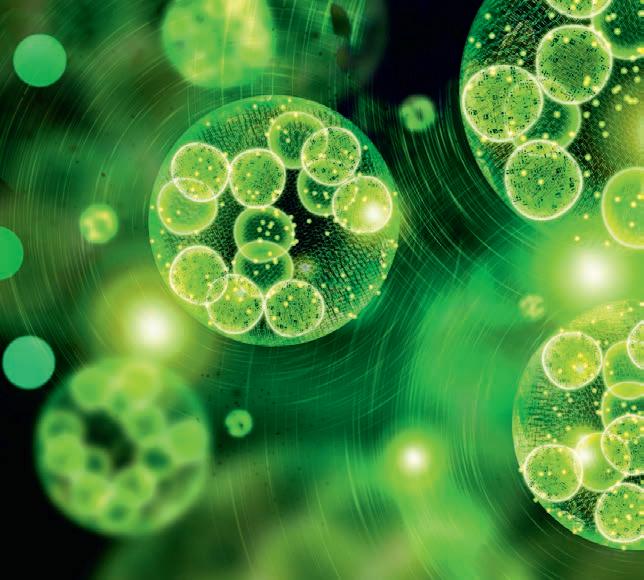
RaySon algal oil, an alternative source of omega-3 specially for salmon feed, improves the quality of the final product for consumers and boosts the

XIAMEN Huison Biotech Co Ltd have been dedicated to the research and production of algal oil for over 20 years, with rich experience and advanced technology.
Using algal oil rich in DHA (docosahexaenoic acid) –Rayson has DHA>55% – makes salmon farming easier and more efficient. Feeding salmon with DHA, an essential omega-3 fatty acid, offers several key benefits including: improved fish health and growth; enhanced nutritional value; boosting the immune system; improved reproductive performance; stress resistance; and


the health of farmed salmon and the quality of the final product for consumers.
RaySon algal oil is rich in important nutrients such as high concentration DHA, which can effectively enhance growth rate, immunity, and survival rate of salmon, and significantly improves meat quality.
The company has independent intellectual property rights throughout the entire process from algae cultivation to production, utilising patented technologies such as mechanical wall breaking, non-solvent extraction, and winterization to ensure the purity and activity of DHA algal oil.
Certified manufacturer and product
This ingredient is non-GMO, kosher & halal-certified and the company is ISO 900 and ISO 22000 certified, with production capacity of 6,000 tons annually.
Choosing Rayson algal oil, is adding core competitiveness to salmon feed. By collaborating with them, farmers will receive highquality products and professional support to jointly promote the development of salmon farming.
Please reach out to us for more information on this product, to discuss cooperation matters, and feature a better future!
E-mail: info@chinahuison.com; ;

These benefits make DHA-rich feeds a key factor in improving both






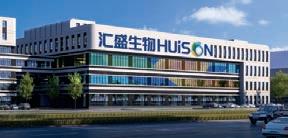
































A £770k project led by a Scottish university will tackle antimicrobial resistance in Vietnam’s aquaculture industry
SCIENTISTS at the University of Stirling have been awarded more than £770,000 to support the roll-out of a new vaccine that could deliver major benefits to the aquaculture industry in Vietnam, one of the world’s biggest producers.
The new project – led by the university’s world-leading Institute of Aquaculture – will build on a previous study that developed an innovative vaccine to tackle antimicrobial resistance (AMR) in Vietnamese catfish and provided insight into the barriers to vaccine use amongst farmers.
The multi-disciplinary team – which includes psychologists and behavioural economists from the University of Stirling – will use the latest funding to support the commercial development of the new vaccine and encourage uptake amongst aquaculture farmers in Vietnam. Ultimately, the project is seeking to reduce damaging antibiotic use which leads to rapid antimicrobial resistance within freshwater farming systems.
Professor Margaret Crumlish, of the Institute of Aquaculture, is leading the new project, which is funded by £774,239 from Canada’s International Development Research Centre and the UK Department of Health and Social Care, under the Innovative Veterinary Solutions for Antimicrobial Resistance (InnoVet-AMR) initiative. This is in collaboration with Dr Le Hong Phuoc and his team from the Research Institute of Aquaculture Number 2 (RIA 2), located in Ho Chi Minh City, Vietnam.
Professor Crumlish said: “Vaccine hesitancy in the Vietnamese Pangasius catfish sector remains high and combined with poor antibiotic stewardship, the sector has reached an AMR crisis.

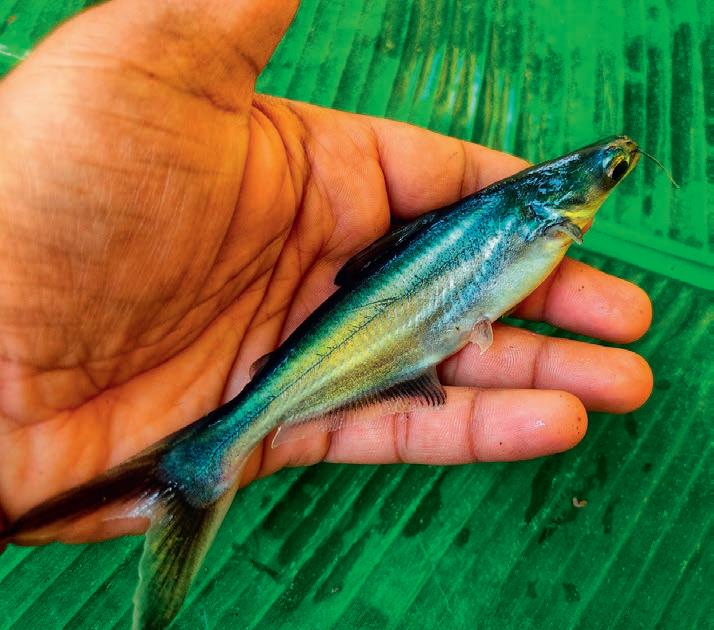





The novelty of this project is not only the new immersion-based vaccine, but the integration of behavioural sciences to directly address vaccine hesitancy and promote vaccination strategies to reduce the threat of AMR.”
Vietnam is one of the largest producers of aquaculture in the world and, over the past 25 years, has been the global leader of the farmed freshwater catfish (Pangasius) sector – with the produce sold in more than 160 countries.
However, catfish suffer from bacterial infections, which result in the widespread use of antibiotics – and previous research has suggested that 80% of farmers lacked a therapeutic approach and, instead, used a cocktail of antibiotics. As a result, the Vietnamese catfish sector is currently in an AMR crisis, which is affecting animal, human and environmental health within freshwater systems.
Vaccine
r mlis Opposite: ietnamese s arm
Although a commercial vaccine against bacterial diseases in catfish has been available since 2013, farmers in Vietnam appear reluctant to use this product.
The first stage of the study, which launched in 2019 and spanned four and a half years, developed improved vaccines against two major bacterial diseases – Edwardsiella ictaluri and Aeromonas hydrophila – that adversely impact the aquaculture sector, and considered the feasibility of introducing them to farms in Vietnam.
The team successfully developed an effective vaccine that works by immersion – submerging fish in the vaccine for a short period of time, before returning them to the pond. Data from the first project showed the new vaccine gave 70% protection against both diseases.
To address vaccine hesitancy, Professor Ronan O’Carroll, a psychologist based in Stirling’s Faculty of Natural Sciences, and economist Professor David Comerford, of Stirling Management School, integrated psychology and behavioural economics to identify the barriers and catalysts around vaccine hesitancy in the Vietnamese fish farming sector. They found a multitude of reasons as to why farmers chose not to effectively vaccinate their fish –including a lack of trust in the vaccine, concerns about future use, inconvenience and cost.
On cost, the team found that the price of the vaccine itself was not the primary deterrent for farmers – but the associated costs with the logistics of administering, such as the employing of vaccination teams and purchase of equipment.
Stage two will seek to move the novel vaccine along the production pipeline and explore interventions designed to encourage farmers away from antibiotic use and towards vaccine uptake. The team will also test whether attitudes to vaccines in general have changed as a result of theCovid-19 pandemicand whether this has reduced vaccine hesitancy among the fish farmers.
Stage two – which runs to October 2026 – involves Ronan O’Carroll, Professor of Psychology; Dr Till Stowasser, Senior Lecturer in Economics at the University of Stirling; Professor Simon MacKenzie and Dr Chris Payne, of the Institute of Aquaculture; and the Research Institute for Aquaculture Number 2 in Vietnam.
Three papers have been published on the results from stage one of the study, with a fourth currently in review.
InnoVet-AMR is funded through the Global Antimicrobial Resistance Innovation Fund, which supports research and development around the world to reduce the threat of antimicrobial resistance in low- and middle-income countries.



You may have heard it said that whilst a jet engine is a complex system, it only becomes complicated when a bird passes through it. Understanding the difference leaves us better equipped to deal with complications when they arise.
Whilst aquaculture systems vary greatly in complexity, they all, perhaps uniquely, are subject to levels and frequency of complication less common in other sectors which is why the intensive cultivation of fish is widely regarded as carrying higher risk than is observed in other similar sectors.
Reducing risk by elevating our understanding of both complexity as well as complications when they arise, is the central purpose of the Wellfish approach to fish health and welfare. By mining, exploring and processing our very large data sets collected from fish that have been cultivated in a wide range of aquaculture systems, biomarker profiles have emerged that are characteristic of those systems.
Thus it is no longer appropriate to speak of a single blood biomarker reference range for farmed Atlantic salmon, but rather reference ranges for Atlantic salmon farmed in ‘x’ or ‘y’ system. However, whilst setting ‘within species’ reference ranges by method of cultivation will produce a ‘normal’ or ‘standard’ profile for each system, this does not always equate to an ‘acceptable’ one. Stock that is compromised, but coping, presents a much greater challenge to the team trying to manage it than one that is operating within the physiological optimum ranges for the species.

The WellFish database is now being interrogated through ‘rule based’ analysis such that the distinction between ‘healthy’ (optimal) and ‘unhealthy’ (suboptimal) can now be made on the basis of clinical biochemistry. We are also now able to provide greater granularity by assigning health scores for gills, metabolic function, and tissue damage. All this is being offered on the new WellFish Tech Production dashboard which is available to aquaculture health and production managers who are routinely monitoring their stocks with us.
For each of the so-called health panels, our traffic light system of reporting remains in place. What is new is that it now comes with a score which can be tracked over time at the level of the farm as well as each of its constituent tanks or pens. In addition to data and insights flowing from the dashboard, users can interact with it by loading on ‘activities’ or ‘events of note’ within the context of biochemistry data and so develop a rich calendar of inputs and outcomes.
As the model develops, its capacity to predict outcomes based upon the clinical biochemistry of stocks that are being routinely monitored is enhanced so strengthening the contribution that health data makes to production decisions.
The WellFish approach allows unprecedented opportunities for health and production managers to redefine the way in which stock health status in Realtime can be included in stock management decisions. This is not just another tool in the box - it’s another box.










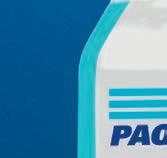






















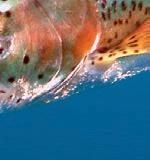







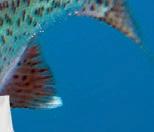

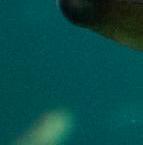







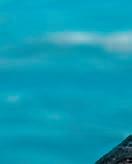

























































Reduces the energetic cost of managing stress, meaning better growth, survival rates and profits.





















Promotes gut health and enhances nutrient absorption. Boosts immunity to reduce disease and parasite outbreaks.
Phibro Aqua is focused on providing the global aquaculture industry with cost effective health management solutions to maximize productivity.

www.phibro-aqua.cominfo@phibro-aqua.com



Europeans consume more aquaculture produce than they grow, Vince McDonagh finds
AQUACULTURE in the European Union is not in a good place right now as the sector grapples with falling consumption and sluggish production activity.
This is the conclusion of two recent reports covering both fish farming and general fishing.
The most recent is an evaluation from the European Fish Processors and Traders Association (AIPCE-CEP) which shows that the salmon supply to Europe fell by at least 5% last year.
One likely factor is consumer resistance to high salmon prices which persisted throughout most of last year.
Much of the salmon sent to Europe is from Norway, its largest provider, and is sent for further processing. But the overall picture is that Europeans are now both producing and eating less seafood of all types.
The downward trend in Europe follows a similar trend to that in the UK, highlighted by a Seafish study earlier this year, although Seafish has since said there are currently signs of a recovery.
The other report, from EUMOFA, paints a broadly similar picture although its data is based on figures from 2021 when Covid

was still widespread.

It says that EU aquaculture production accounted for only 28% of the global total of fishery and aquaculture products (FAPs) production.



Patterns and market trends vary across member states and across species, with markedly higher consumption in some countries.
The EUMOFA report also says that EU farmed products face various market positioning challenges including the need to adapt to climate change, overcoming resource scarcity, coping with increased production costs, and facing up to strong competition from third-country products.
It should also be noted that 12 months earlier the EU suffered an important setback when it lost the world’s third largest salmon producer in Scotland as a result of the UK leaving the community.
So, with the possible exception of Ireland, the EU no longer has a salmon-producing country of note.
The figures from the European Fish Processors and Traders Association are the most relevant – and the most worrying.
The association says that if all EU aquaculture and catches for food use were retained and consumed within members






states, they would account for only 31.3% of total available supply to those states.
But as much of what EU countries produce is exported; in reality domestic supply only covers 14.2% or less than half of overall consumption.
AIPCE-CEP says the EU’s dependence on imported materials for its markets has remained exceptionally high, particularly following the UK’s exit from the EU.



In 2023, this dependence decreased to 62.2%, largely due to stable EU production and a decline in imports from third countries.
Salmon is the most popular fish on the Continent with Norway the largest supplier, followed some way behind by the Faroe Islands and Scotland.
Last year, the report notes, the consumption of Atlantic salmon within the European Union fell by 5% or 65,000 tonnes to 1,327,000 tonnes.
Salmon from Norway mostly enters the EU’s 27 member states by road via Sweden, Denmark and Poland, where the fish are processed for further distribution throughout the union.

Despite repeated calls for Norway to process more at home, forwarding to the “EU 27” remains a more economic option for producers, because labour costs can be much lower.
much lower.
Salmon has become an essential species for the EU’s seafood processing plants, especially in Poland, Netherlands, Belgium, Denmark, France and Spain. Filleting and cold/warm smoking are the most important processing steps.
especially in Poland, Netherlands, Belgium,
The association said: “In AIPCE-CEP, we continue to observe a growing diversity in species, frequency and consumption patterns as innovations in packaging, logistics and access create new opportunities for consumers to enjoy fish more frequently and in varied forms.
“In 2023, inflation across the EU impacted seafood sales. Consumers shifted from more expensive species to lower cost alternatives, such as cheaper fish, meat or poultry.
we continue to observe a growing diversity in species, frequency and consumption patterns as innovations in seafood sales. Consumers shifted from poultry.
stored in cold facilities was often sold
“Consequently, high-priced seafood stored in cold facilities was often sold below cost price or with minimal margins to remain competitive.
remain competitive.





“This led to a decline in financial performance for many companies within the EU seafood sector in 2023. Towards the end of last year, traders and industry players sourced increased volumes of seafood from Russia, benefiting from preferential tariffs under the ATQ [autonomous tariff quotas] regulation.”
ATQs are temporary import restrictions that allow a certain quantity of a good to be imported at a reduced tariff or duty-free for a set period of time.
The AIPCE-CEP report adds: “From 2024, Russia was excluded from these tariff advantages. Additionally, since 2023, mediumand high-risk seafood products destined for the UK must be accompanied by a health certificate.
“Although trade flows have stabilised, trading with the UK now presents challenges similar to exporting to other third countries.
“To ensure continued access to market opportunities, it is essential that the industry is not hindered by unnecessary tariff or non-tariff barriers. “
Maintaining access to raw materials through the ATQ system, without duties, is crucial, it stresses.
Imposing duties increases costs for consumers, potentially leading to reduced sales and putting pressure on EU-based production. This could result in production moving outside the EU, the organisation warns.
The EUMOFA report, as well as outlining the market positioning challenges already mentioned, suggests that the aquaculture sector in the EU is also characterised by a low level of organisation in the industry, which has the effect of limiting its bargaining power and investment capacity.
The aquaculture sector in the EU is diverse. It includes some large-scale operators with the capacity to invest, but it also comprises many small-scale companies with limited resources and these will find it harder to adapt. Producers must continuously take account of changing consumer preferences and retailers’ requirements, the report adds.

WHILE Norway and the EU remain in dispute over the provision of low category production salmon, the UK is becoming an increasingly important source for salmon in general, says AIPCE-CEP.
According to Norwegian law, the fish must have wounds and deformities removed before it is exported but the European Commission has classed this as a trade barrier and is pushing for the restriction to be removed.
The organisation adds: “UK became an important new third country where salmon products were imported from into the EU 27. “Materials are mainly originated from Scotland mariculture of Atlantic salmon. Some 85% of the 59,000 tonnes imported from UK consisted of whole, fresh salmon,” it adds.
THE European Fish Processors and Traders Association (AIPCE-CEP) represents 19 EU National Associations from 12 member states and three national associations in third countries (UK, Norway and Morocco).
It accounts for more than 3,900 enterprises and 128,000 people of which more than 80% are at EU level.
The value of the output of the industry represented by AIPCE-CEP amounts to around €30 billion (£25bn) or about three and a half times the turnover of the entire EU catch sector.







SEABED sampling to assess the impact of fish farms could be speeded up significantly through the use of environmental DNA technology, a research project has concluded.
The “MeioMetBar” study took the form of a six-year collaboration between regulators, researchers and fish farmers in Scotland and Germany.
Marine benthic invertebrates are essential for maintaining the natural ecosystem, helping to process biomass and protect the health of farmed and wild fish. These sediment-dwelling animals can also act as bioindicators of the effects of human activity on seabed health. Because of this, they are monitored by the Scottish Environment Protection Agency (SEPA) and operators of marine fish farms to ensure that farms are operating sustainably.
A new environmental-DNA (e-DNA) approach for monitoring the seabed conditions around marine fish farms could significantly speed up the assessment of sediment samples, enabling salmon

producers and SEPA to gather timely, accurate information to demonstrate environmental impact and recovery.

Previously, benthic monitoring relied on scientists painstakingly picking out all the invertebrate animals from samples of seabed sediments and then identifying each animal with the aid of microscopes. However, the process can take up to three days for a single sample and estimates suggest that it is costing the aquaculture sector up to £1 million per year.

barcodes from the sample against a database of known barcodes for thousands of bacterial species to determine the bacterial species present in the sample.

An alternative, faster and more cost-effective process is now available, drawing upon DNA techniques first used in human forensics to identify the organisms present in sediment samples. Scientists have used metabarcoding – a technique that cross-references samples against a sequence database to identify different species – to identify thousands of bacterial species simultaneously.
After gathering a sample, the bacteria present in the sediment is first characterised using DNA. This analysis step involves:
• Using high-throughput sequencing techniques to read the sequence of DNA (or barcode) for a specific, short region of bacterial DNA extracted from samples of seabed sediment.
• Cross-referencing the identified
A machine learning model is then applied to predict the health of invertebrate community based on the bacteria. The Infaunal Quality Index (IQI) – a metric used to assess the ecological quality of marine benthic habitats, particularly focusing on the communities of infaunal organisms, the aquatic animals that live in the substrate of a body of water and which are especially common in soft sediments – is then used to classify the health of the invertebrate community.
Following an extensive six-year project, samples analysed using the new method are now being presented to SEPA for validation, with an open-source toolkit and standard operating procedures also being created for anyone in the sector to use.
The research was supported by the Sustainable Aquaculture Innovation Centre (SAIC), Institute of Biodiversity and Freshwater Conservation at UHI Inverness, Mowi (Scotland), SEPA, University of Kaiserslautern in Germany, Scottish Sea Farms, Salmon Scotland and lead research partner, the Scottish Association for Marine Science (SAMS).
”Armed
‘The practical outputs are very promising’
Stephen Macintyre, Head of Environment at Mowi Scotland, said: “Demonstrating good environmental performance at our sites is critical, both for our customers and for compliance reasons. At the moment, we sample the seabed followed by sieving and sorting sediment to identify species, but it is a time-consuming, labour-intensive process that hasn’t been updated for 30 years or so.
“As an alternative, the DNAbased approach will enable us to understand our environmental performance much quicker, almost in real time, and take action where required to improve the environmental picture. Environmental DNA is already widely used elsewhere for nature-based assessments and also has the potential to be applied to assess the wider marine biodiversity that exists around our fish farms. The
practical outputs from this project are very promising, and we are now in talks with SEPA about integrating DNA-based compliance assessments into our site monitoring programme.”
Technical components of the research, including DNA sequencing, data analysis and statistics, and the development of a machine-learning algorithm to predict the IQI of samples based on their bacterial characterisation, were independently reviewed by Biostatistics Scotland.
Sarah Riddle, Director of Innovation and Engagement at SAIC, added: “This project has been years in the making and it is great to see the results of a long-term collaboration between the sector, academia, and regulators having the potential to transform a key aspect of aquaculture monitoring.







E-DNA sampling could provide widespread benefits to both the aquaculture sector and its regulators, with potential for this approach to be adopted across the globe by seafood producing nations. Armed with data, producers can be better informed to make decisions around key environmental and fish health factors influenced by the seabed.”
Peter Pollard, Head of Ecology at SEPA, said:
“The MeioMetBar Project has been an important and successful collaboration. It is truly the beginning of a step change in our ability and that of fish farm operators to costeffectively assess, manage and regulate the effects on seabed life of fish farm discharges and so help protect the health and biodiversity of Scotland’s seas.
with data, producers can be better informed to make decisions









“The research is an example of the rapid innovation now taking place in more efficient and effective ways of monitoring the environment. Work is already underway to expand and enhance the capabilities of the method developed by the project, with the nextgeneration method expected to be available in 2025.”




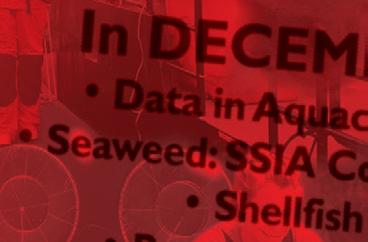












LAST year it was St John’s, in New Brunswick, Canada. Next year it will be Cartagena, Colombia. But in 2024, the venue for the Global Seafood Alliance’s Responsible Seafood Summit was St Andrews on the east coast of Scotland – better known, it must be said, for its status as the home of golf than as a seafood hub.




of this year’s summit. The level of interest from major retailers - the highest attendance in the event’s 23-year history – demonstrates the increasing importance of issues such as food security and seafood’s appeal as a lean, healthy protein as the world’s population continues to increase.

The summit was co-hosted by the Global Seafood Alliance, a not-for-profit industry body dedicated to promoting sustainable seafood production, and national industry body Seafood Scotland.

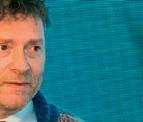





More than 340 people attended the event at the Fairmont Hotel, overlooking the North Sea and one of St Andrews’ many golf courses. Although there was some time set aside for recreation – including the odd game of golf, and even crazy golf in the hotel – there was a packed programme covering key issues in aquaculture and catch fishing.
The GSA’s annual updates on finfish and shrimp aquaculture, collated by market experts at Rabobank and Kontali, gave a picture of the industry in 2024 and predictions for the next few years (see Outlook, starting page 58, for details).
“Increasing seafood’s share” was the theme
AI will change everything
On the opening day of the summit, Chris van der Kuyl, IT entrepreneur and Chairman of aquaculture technology business
Ace Aquatec, gave a keynote address with a strong message: artificial intelligence can help aquaculture address its biggest challenges.
The increasing capabilities of information technology, and artificial intelligence in particular, have implications for aquaculture and for the seafood sector as a whole, he argued. Applications range from monitoring fish health and feeding optimisation to biomass measurement and environmental monitoring, he said.
And he stressed: “Data-driven decisionmaking is absolutely key.”
Also at the opening day of the conference, Mairi Gougeon, Cabinet Secretary for Rural Affairs, Land Reform and Islands in the Scottish Government, welcomed delegates in a video message, and Scotland’s Deputy First Minister Kate Forbes gave the final address of the morning.



Van der Kuyl, who among other claims to fame was part of the team who created the global gaming phenomenon Minecraft, said: “We are living in a time with the fastest pace of change in human history, but the pace of change will never be this slow again. The future promises faster innovation, reshaping industries and societies at unprecedented speeds. This can be exciting and utterly terrifying.”

Kate Forbes said: “Scotland’s marine industries play a vital role in securing and growing prosperity across the country – not least within our coastal communities.








“Our thriving and sustainable Scottish seafood industries produce worldclass seafood products with annual exports worth over £1 billion. The Scottish Government’s clear message is that this is a country that is open for business. We will continue to work with industry, businesses and key partners to

continue delivering the Scotland Food & Drink Export Plan and help ensure our seafood industries continue to flourish and grow.”
Fish waste and fireside chats
Salmon Scotland Chief Executive Tavish Scott and Gilpin Bradley, former Managing Director of Wester Ross Salmon and now an angel investor, discussed industry issues in the form of a “fireside chat”.
Bradley explained how Wester Ross got started back in 1964, and shared some of the insights he has learned from being part of that journey. He stressed the importance of choosing the right strain of fish, and finding the right market for your product, but he also stressed: “It’s ‘people first’. Choose the right team and everything else will follow.”
Customers can also help your business grow, he said: “An A-list customer is one who will promote your product and name check you on their menu!”
Donna Fordyce, CEO of Seafood Scotland, told the conference: “The seafood industry is determined to continue to modernise and innovate, with a particular focus on generating new income streams by using more parts of the fish and reducing waste.
“We plan to create a ‘Scotland Ocean Cluster’ to ensure that collaboration is happening at the highest level, and that Scotland is in the strongest position to attract private and public sector investment.
“A key ambition for the industry is to work alongside the major retailers to get more responsibly sourced seafood onto supermarket shelves and featured on restaurant menus. There’s so much potential there.”
A key focus for Seafood Scotland is reducing waste in the seafood industry, by finding value for “sidestreams” in fish processing. This was also the topic for a presentation by Alexandra Leeper, Chief Executive of the Iceland Ocean Cluster, who described how Iceland’s “100% fish” had, as a response to tighter cod quotas, been

able to find significantly more value from each fish caught.
The summit also featured a panel discussion on the “spatial squeeze” increasingly found in coastal waters where users such as fisheries, aquaculture and offshore energy businesses are competing for space. The panel, including Tavish Scott, Elspeth Macdonald of the Scottish Fishermen’s Federation and Fingal McKiernan of SSE Renewables, agreed that governments have a key role to play, and that policy must be based on better scientific evidence than is available at present.
Welfare – for fish and people
Wednesday morning saw a discussion on animal (and human) welfare in the seafood industry. An important message was that welfare is or should be a win-win game.
For example, the working conditions of employees in processing centres are much improved – and factors such as staff turnover and commitment are better – where humane slaughter methods are in place.
Similarly, looking after the welfare of stock in aquaculture must be a priority.
Linda Wood, Aquaculture and Fisheries Manager with retailer Marks & Spencer, said: “It’s just better business. With better welfare, more animals will survive and you will get better quality.”
Dr Sara Barrento, of training and consultancy group FAI, said: “Once you see welfare, you can’t unsee it.”
A panel of retailers, representing Tesco in the UK and Walmart, Southeastern Grocers and Red Lobster in the US, shared insights on consumer behaviour and how to sell seafood at a time when it is a comparatively expensive source of protein. They agreed that telling the “seafood story” is crucial. So is collaboration, stressed Walmart’s Andrew Lindstrom: “You go fast alone, but you go further together.”
Other topics discussed at the summit included the journey to net zero, how to develop leadership in seafood and how aquafeed can become more sustainable.
The final day of the summit saw the opportunity to go on field trips to see the seafood sector in action, including the Loch Fyne Oyster farm, the Rastech trial shrimp farm in St Andrews itself, BioMar’s Scottish feed mill, JK Thomson’s processing and smoking plant in Musselburgh and the DFDS logistics hub at Larkhall, near Glasgow.
See our video interviews with Donna Fordyce and Chris van der Kuyl at www. youtube.com/@fishfarmermag
The next Responsible Seafood Summit takes place in Cartagena, Colombia in the week commencing 29 September 2025. More details will be available in due course at events.globalseafood.org.

chat’
Chris
There’s so much potential there
Industry estimates suggest that seafood production is due for a period of growth after a difficult spell
THE Responsible Seafood Summit included several presentations on the performance and prospects of the seafood industry.
On the opening day, Marcus Coleman, CEO of Seafish, the public body that supports the UK seafood industry, said he was confident there are signs the industry is on the road to recovery following an extremely challenging five years.
In a presentation titled “Choppy Waters: How the UK Seafood Industry is Navigating Post Brexit Trade”, Coleman revealed that the combined value of UK seafood imports and exports fell by around a billion pounds from the start of this decade. The statistics he shared showed that global factors had caused a fall from £6.45bn in 2019 to £5.28bn in 2024.
“Seafood trade reached a peak of almost £6.5bn in 2019 and things were looking bright,” he said.
“Consumer confidence was strong and the economy was in growth, although worries were bubbling up about the effect Brexit might bring about.
“It’s clear that what happened between 2019 and today created a challenging

landscape for seafood trade.”
The 2020 pandemic disrupted supply chains and slowed down logistics with lockdowns leading to lower volumes of seafood being caught, processed and traded in the UK and internationally.
December 2020 marked the end of the transition period when the UK left the single market and customs union. This created barriers to trading with the EU in the form of paperwork and border checks. Shellfish exports to the EU were the most impacted, with annual value falling by £152.1 million (27%) compared to pre-2020 figures.
Since then, the Russian invasion of Ukraine has led to higher energy prices with Western countries, including the UK, also imposing economic sanctions on Russia, including a 35% tariff on whitefish consigned from the country.
A cost-of-living crisis in the UK and disruption to trade routes due to the war in Gaza further impacted the seafood industry with cod, tuna, Alaska pollock and mackerel suffering the most serious declines in import value.
But indications from the start of 2024 show consumer confidence is beginning to return, Seafish says, with recorded export value growth at 7.9% on the previous 12 months.
Seafood imports remain steady with salmon and cheaper whitefish alternatives to cod such as haddock, pangasius, hake and tilapia enjoying notable improvements.
Coleman welcomed the figures but added the entire sector still had work to do to complete its recovery.
He added: “There are reasons to be optimistic… the first half of the year is, at last, showing growth and total trade is moving in the right direction again, although it’ll be a long climb back to pre-2020 levels.
“For the bounceback to be complete, there also needs to be increases in the retail and food service sectors, although we understand market analysts are suggesting a cautious outlook.”
Finfish catch outlook
Janice Schreiber, Managing Editor, Expana

Markets (formerly Urner Barry), provided a glimpse into the supply and pricing dynamics for three key wild catch species: pollock, cod and salmon.
She confirmed that wild catch generally remains flat compared to aquaculture, with cod quota reductions in several harvesting areas expected for 2025, especially in the Barents Sea, while the cod market is still also suffering disruption arising from Russia’s invasion of Ukraine.
The world pollock supply is stable, she said, but the Gulf of Alaska harvest saw a fall of 50,000 tonnes in its harvest this year, while sanctions in various farms are being applied to Russia by the US and EU.
For wild salmon, while 2023 represented a good year for the Alaskan salmon trade, the 2024 salmon season has so far yielded less than 100 million pounds in weight, 70% below forecast. Wild salmon exports from the US for the year to date are, trailing 2023 by 9%, she said.
As ever, one of the highlights of the summit was the annual GSA Global Finfish Production Survey & Forecast, presented by Rabobank’s global seafood specialist Gorjan Nikolik, based on data and industry polling collected by Rabobank and analysts Kontali. Nikolik was cautiously optimistic on the salmon front, with Norway back to growth mode after a couple of difficult years and good news from other producing nations –particularly Scotland.
Norwegian production of salmon is forecast to go up 3% this year, with a further 2.2%
growth in 2025 and 5.3% in 2026. Scotland appears to be the real success story, however, following two very challenging years in 2022 and 2023. Production in the current year is anticipated to be up 15% year on year, with projected increases of 7% and 6% over the following two years.
At an estimated 12% increase for production this year, followed by 13% and 4% in 2025 and 2026, prospects are also looking good for Faroes. Of the smaller producers, Nikolik flagged up Australia, Iceland and land-based farming as “ones to watch” in the near future.
In Chile, the second biggest producer of Atlantic salmon, the picture is not so positive, with production falling this year by an estimated 7.7%, and predicted annual growth of 1.4% and 3.2% is not expected to get the industry back to 2023 levels.
Canada, meanwhile, is expected to grow at a modest 6%, followed by 3% for each of the following years – which will not bring the industry anywhere near its 2018 high. This is perhaps not surprising, given the federal government’s determination to end opennet aquaculture in British Columbia.
Kontali’s forecast for global Atlantic salmon production, at a little under three million tonnes, represents 1.7% growth this year, followed by 3.5% and 4.9% in the following two years, meaning that the industry is expected to surpass 2021 levels in 2025.


After two years of decline,



This would still mean growth at a lower rate than to 5.8% CAGR (compound annual growth rate)
Production of large rainbow trout continues to be something of a rollercoaster ride for Chile, the biggest producer, with steep estimated rises in 2024 and 2026 offset by production falls in 2023 and 2025, with production less than a quarter of its 2012 peak.
For coho salmon, effectively a Chilean speciality, the survey predicts a 14% slump this year followed by flat production levels for the next two years.
Sea bass and sea bream production in the Mediterranean continues to grow, albeit at a less dramatic pace: an estimated 1.9% compared with CAGR of 5.5% over 2012-2022. This reflects flat figures for the second biggest producer, Greece, but better growth in Turkey and more dramatic increases for smaller players such as Italy and, especially, Croatia.
Global tilapia production, which this year is expected to pass the seven million tonne mark, is expected to continue its dramatic growth, at 4.1% this year followed by 4.7% in 2025.
While growth in tilapia production is flat in the biggest producer, China, second-placed Indonesia continues to grow more rapidly at an estimated 5.4% this year, while Egypt is getting back to its preCovid peak.
Nikolik singled out Thailand, Zambia, Ghana, Kenya and Brazil as smaller players to watch in this sector.
Pangasius, also known as striped catfish or basa, has been a major success story for Vietnam and this is expected to continue, with 8% growth estimated for this year. Worldwide, even though total production reached the 3.5 million tonne mark this year, this sector continues to expand impressively, with a year on year increase of 3.3% this year and 6.8% next year.
Looking at other species, Nikolik highlighted carp, which is still a major sector especially in China – grass carp alone is expected to reach 6,000 tonnes in that country this year – but appears to be no longer growing. He said that carp production is still growing at a slow pace in countries like India and Bangladesh, but consumption in China and elsewhere can be expected to decline in the long term.
What happened between 2019 and today created a challenging landscape
Looking at smaller sectors, production of marine finfish like pompano, grouper and barramundi (Asian sea bass) is on the rise, especially in Asia.
Farmed Atlantic cod in Norway, although production is still less than 20 tonnes, is set to see a significant increase of 45% this year, with further growth to come over the next two years.
In conclusion, Nikolik said, for western markets the supply side outlook is looking good. The survey also included an annual list of industry concerns, for which the top were:
1. Cost of aquafeed
2. Disease prevention
3. Broodstock quality
Salmon facing headwinds
Ragnar Nystøyl, Chief Analyst at market research business Kontali, also gave an overview of the salmon sector. This year is expected to see a continuing fall in the proportion of wild catch salmon in the global total. Although farmed salmon is expected to grow only modestly this year (1% according to Kontali’s estimate) the expected catch for wild salmon is down 55%.
Since 2000, the global production of farmed salmon has shown a compound annual growth rate (CAGR) of 3% while wild catch has seen a CAGR of -12%.
Despite continuing growth, Nystøyl said the farmed sector is facing “headwinds”, especially in terms of the “licence to produce”. This, he said, comes with a higher and higher cost:
• regulatory capacity is becoming scarce and more unpredictable, and decisions are more political
• good sites (sea area); a scarce resource, for which fierce competition exists between salmon aquaculture and other interests and stakeholders;
• this “licence” is only granted in exchange for wider, deeper and more committed responsibility and operational quality; and
• fish health and fish welfare + environmental and social footprint have become crucial factors.
The fight, he stressed, is principally to maintain production rather than to grow. In addition, the cost of input factors such as feed has gone up significantly, and producers are having to put more in to achieve the same results as previously.
Despite the industry’s challenges, however, 2024 is shaping up to be a better year and Nystøyl said worldwide production growth for 2025 is around 4%-5%.
On the second full day of the summit, Gorjan Nikolik turned to the shrimp industry. The star performer right now is Ecuador, he said, where production of L.vannamei (white


leg shrimp) had rocketed 14% in 2023 and this year was still expected to grow by between 2% and 4%, reaching around 1.3 million tonnes. Mexico, Venezuela and Brazil are also growing.
Above:
In India, Nikolik said, farm production has been curtailed by low prices and some farmers are switching from vannamei to monodon (black tiger prawns). China continues to grow its shrimp production, however, with Rabobank estimating 4% growth for that country’s total shrimp production. Reconciling China’s official production statistics with industry estimates was hard, however, he stressed.
Vietnam is back to growth after experiencing a contraction in 2022 and 2023, the Rabobank survey suggests, with a 1% increase expected this year bringing production to just over 700,000 tonnesstill considerably below the industry’s 2021 peak, however.
The global picture shows 2024 coming in with 1% growth, to just under six million tonnes, accelerating to 2% next year. The biggest producers are Ecuador, China, India and Vietnam.
Kontali analyst Ida Seljevoll Skancke also gave a presentation on the dynamics of the shrimp market.
Key takeaways were, she said:
• China: Decline in imports in 2024, minor recovery expected by Q4
• EU: Strong H1 imports, positive outlook for the rest of the year; and
• USA: Early year growth, slower summer, but Q3 recovery.
The Chinese market remains pivotal to the shrimp industry’s success, she stressed, but EU countries and the US are becoming enthusiastic importers of shrimp again.
The fight… is principally to maintain production rather than to grow
ACOMPANY set up to create economic value from hatchery fish that do not make the grade was one of the winners in the Responsible Seafood Innovation Awards, held on the first full day of the summit at St Andrews.
Tiny Fish, which finds unique markets for small salmon from Scottish hatcheries that are removed during the freshwater phase of production to allow the best salmon to be raised at sea, was named as Aquaculture Innovation of the Year at the awards, announced at the Responsible Seafood Summit in St Andrews, Scotland.
The winner in the Fisheries category was predator deterrent company Genuswave.
The awards were organised by the Global Seafood Alliance (GSA) as part of the Responsible Seafood Summit and sponsored by the US Soybean Export Council (USSEC).
Tiny Fish was co-founded by experienced aquaculture professionals Teresa Garzon and Jarl van den Berg, who is also General Manager at hatchery Landcatch. Juvenile salmon are routinely graded to minimise variability within the growing tanks, and thus, improve animal welfare. Sometimes, the smallest salmon are euthanised with anaesthetics and removed from the population, as they will be too small to be successfully transferred to sea. These small fish are typically repurposed into biogas or compost as the use of anaesthetics prevents them from being consumed for nutritional, value-added purposes.
Tiny Fish is addressing this issue by euthanising the fish with an instant electrical shock, using Ace Aquatec’s humane stunning system. The solution offers high efficacy regarding fish welfare and slaughter, and works to ensure that every fish can be harvested and sold for nutritional valueadded purposes.
As a result, fish that had been used as compost or incinerated are now being used for high-value pet food, or even for human consumption.
Teresa Garzon told Fish Farmer: “I think the award represents support and recognition that we are doing something right!”

Deterring predators safely
Genuswave has developed targeted acoustic startle technology (TAST) to safely deter marine mammals from getting too close to fishing vessels. TAST is also used to protect fish in marine pens and to keep marine mammals safely away from underwater operations such as piledriving for wind farms.
The technology was developed by researchers at the University of St Andrews in conjunction with Genuswave. Unlike traditional acoustic deterrent devices (ADDs), which typically use a constant, loud sound over a wide sound spectrum, TAST does not create problems for non-target species and predators like seals do not become habituated to the sound. The emissions are not audible to fish.
In fisheries, TAST has been shown to lead to a significant reduction in seal and other predator incidents, and increased catches for the fishing vessels.



The award represents… recognition that we are doing something right
















Also shortlisted as finalists for the Aquaculture category were Ace Aquatec, for its A-BIOMASS system, which uses sophisticated camera technology and artificial intelligence to estimate biomass of fish in pens; and Seaqure Labs, a Swedish company that has developed alternative proteins for aquafeed using fungus grown on agriculture sidestreams.
The other finalists in the Fisheries category were Green Iceberg, which uses tiny particles of ice to create a super-cooling system to keep fish fresher for longer; and Global Fishing Watch for its “Vessel Viewer” system, which makes it possible to track fishing vessels internationally and highlights potential unlawful and unmonitored fishing activity.





















The ceremony also saw an award presented to Simão Zacarias, a post-doctoral researcher at the University of Stirling. He was the Innovation Award winner for 2020, when the Covid lockdown prevented in-person events from being held.
Scan the QR code right to see Fish Farmer’s interview with Teresa Garzon here

Seawork, the European commercial marine and workboats exhibition, connects businesses to showcase innovations, solutions and new products. The event, taking place over 10-12 June 2025, features demonstrations, launches and announcements, with visitors able to explore the latest industry trends. Speed@Seawork returns to Cowes, Isle of Wight, in 2025 for its sixth edition, featuring fast vessels in security, intervention and rescue operations.
The Seawork Awards recognise excellence in the commercial marine sector, highlighting outstanding innovations from companies and individuals across Europe. seawork.com
Slàinte! MiAlgae in circular economy deal with whisky distillery
Independent Scottish distillery Eden Mill has announced a partnership with biotech company MiAlgae to repurpose whisky effluent, a by-product of distillation, to grow microalgae as a sustainable source of Omega-3s for aquafeed and other uses. MiAlgae will use whisky by-products from Eden Mill’s distillation process to nurture Omega-3-rich microalgae. Global demand for Omega-3s, traditionally sourced from wild-caught fish, is driving unsustainable overfishing, butalternative ingredients are seen as a way to alleviate demand. MiAlgae has recently been recognised as a finalist for the Earthshot Prize, which highlights examples of environmental innovation.



FiiZK to supply closed cages for Norwegian farmer
Aquaculture industry supplier FiiZK has been awarded a contract to deliver two large, closed fish cages to an undisclosed Norway-based fish farmer. FiiZK will supply two of its “Protectus” closed fish cages which have a perimeter of156 metres and a volume of approximately 30,000 cubic metres. Six seawater intakes at 30 metres water depth provide abundant fresh, lice-free water to the closed fish cage. FiiZK will manufacture and deliver the closed fish cages at its headquarters in Trondheim, Norway, its Mjåtveit facility outside Bergen, Norway, and using sub-suppliers.
Fish farmers now have a powerful new tool at their disposal with the launch of the Peri-Scope Quantitative Plankton Classifier. This innovative device allows for real-time, on-site analysis of plankton levels, delivering quantitative data and automatic classification without the need for lab testing. Farmers can now quickly assess water quality, monitor plankton populations and take immediate action to optimise conditions for fish health and growth. Designed for ease of use in the field, the analyser offers a reliable, cost-effective way to prevent potential issues and increase farm productivity. It’s a game-changer for the aquaculture industry. Visit www.peri-scope.com for more information.

The latest aquaculture events, conferences and courses
NOVEMBER 24
SCOTTISH SEAWEED INDUSTRY ASSOCIATION
www.ssia.scot
Corran Halls, Oban UK
November 19-21, 2024
SSIA is an organisation dedicated to the growth and innovation of the seaweed industry.
AFRAQ 2024
www.was.org
Hammamet, Tunisia
November 19-22, 2024

24
ALGAEUROPE 2024
www.algaeurope.org
Athens, Greece
December 10-13, 2024
Venue: Divani Caravel Hotel Conference on science, technology and business in the algae biomass sector.

MARCH 25
AQUACULTURE 2025
www.was.org
New Orleans, Louisiana USA
March 6-10, 2025

SEAGRICULTURE ASIAPACIFIC 2025
seagriculture-asiapacific.com
Adelaide, Australia 18-20 March 2025
APRIL 25
WORLD AQUACULTURE 2025 CHINA
www.was.org
Qingdao, China
April 24-27, 2025
MAY 25
AQUAFUTURE SPAIN 2025
www.aquafuturespain.com
Vigo, Spain
May 20-22, 2025
Venue: IFEVI Exhibition Center
An international meeting space for the Spanish aquaculture industry.
JUNE 25
SEAWORK
www.seawork.com
Southampton, United Kingdom
June 10-12, 2025
Europe’s largest on-water commercial marine and workboat exhibition.

SEAGRICULTURE EU 2025
www.seagriculture.eu
Rotterdam, The Netherlands
June 17-19, 2025
Leading conference for the seaweed industry in Europe
WORLD AQUACULTURE SAFARI 2025
www.was.org
Entebbe, Uganda
June 24-27, 2025
AUGUST 25
AQUA NOR 2025
www.aquanor.no
Trondheim, Norway
August 19-21, 2025
The world’s largest aquaculture technology showcase.

25
AQUACULTURE EUROPE 2025
www.aquaeas.org
Valencia, Spain
September 22-25, 2025

OCTOBER 25
LACQUA 2025
www.was.org
Puerto Varas, Chile
October 6-9, 2025
FEBRUARY 26
AQUACULTURE AMERICA 2026
www.was.org
Las Vegas, Nevada, USA
February 16-19, 2026

JUNE 26
WORLD AQUACULTURE SINGAPORE 2026
www.was.org
Singapore, June 2-5, 2026

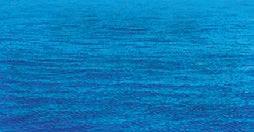














































































































By Nick Joy
HOW can this be? I sit here with a blank sheet of paper the day following one of the most critical Budgets in the last two decades without a thought in my head. I suppose that the sheer awfulness of the proposals is giving me a block but it also may be that so much of it had already been leaked that it seems hard to write a story about it.
Yet I must say something about an event which burdens business even more. We do not need any more bureaucrats living off us, let alone ones which are paid so much more than our hard-working staff. We don’t need any more regulations and rules stifling enterprise and investment which creates the jobs and the money with which we pay our staff.
We are a fragile industry which exists in some of the most difficult places in the world to do business. Small populations and high service costs mean that businesses have to carry higher overheads just to exist. The fact that we produce a healthy protein and feed so many people will not protect us against the overweening government monolith.
I am sure that there will be those who praise the new employment rights and increased minimum wage etc that the government proposes. As one who always wanted to create jobs with good remuneration, I can understand that. The problem is, of course that the government is spending someone else’s money. In fact, the whole strategy depends on the enthusiasm and risk-taking of business.
so the smaller enterprises suffer disproportionately.
” The problem is… the government is spending someone else’s money
It would be fair to say that I am a little disheartened at the moment, though there are a few glimmers of light out there. I am told that farming courses are seeing an uptick in applications which is hopeful. I am not sure if this is the same for aquaculture courses, but I hope so. The price of food is rising and whilst I am sorry that this is the case, we have to go back to a place where food is expensive so that people waste less. For me, expensive food means that the people who work in the rural environment will be valued and get higher wages. So I hope this trend continues. Meanwhile I will have another glass of whisky and brace myself for what’s to come when the Budget announcements take effect.
Government does not have to grow the fish, process it, transport it or sell it at a profit. It is expected that someone will do that in order that these extra wages can be paid. It is so easy to give away what is not yours in the first place. Especially as it has been confirmed that government is also going to take more money from business in National Insurance.
If that were the only problem then our industry would find it bearable but each government promises us to make our life easy while making it harder. The amount of analysis of farming performance in both agriculture and aquaculture grows year on year. Too often it is to prove that we are not doing the damage that critics say we are.
I see a tough few years ahead. The Scottish government is still reviewing what it thinks of salmon farming, and I think that the business environment here is going to get worse before it gets better. I sincerely hope that I am wrong but the evidence is pretty damning.
The future for small business is worse, which does not affect salmon farming so much but remember all the other species and the size of their businesses. Like agriculture we suffer from the lack of interest in our industry in the education system. All of these effects are compounding


























































